Weather
Temperature
5.5°
French tunnel entrance apron
1.5°
Italian tunnel entrance apron
Mont Blanc Tunnel traffic
21/02/2025 07:30 Traffic will be totally stopped from 24/02/2025 23:30 to 25/02/2025 02:00 due to maintenance works
Weather
Temperature
5.5°
French tunnel entrance apron
1.5°
Italian tunnel entrance apron
Mont Blanc Tunnel traffic
21/02/2025 07:30 Traffic will be totally stopped from 24/02/2025 23:30 to 25/02/2025 02:00 due to maintenance works
History
One tunnel, two countries, fifty years of history
On September 15th, 1962, Amintore Fanfani, Head of the Italian government, and Georges Pompidou, Prime minister of the French Republic, inaugurated the drilling of the Mont-Blanc tunnel and realised its first official crossing. Three years later, on 16th July 1965, the Presidents of the Italian Republic and of the French Republic, Mr Giuseppe Saragat and Mr Charles De Gaulle, inaugurated the Mont Blanc. Three days later, on 19th July, the first cars went through the opening of what was, at the time, the longest road tunnel in the world beneath the highest mountain in Europe.
Close to Switzerland, the Mont-Blanc Tunnel established an essential local and inter-regional route of exchange between France and Italy. It is equally an axis of exchange, for the mobility of persons and goods, between the northwest and the southeast of the European continent. The history of the Mont-Blanc Tunnel reflects that of France and Italy during the last two centuries. This human adventure is not only an example of great technical realisation but also a symbol of the desire that has always driven man through the ages: to overcome the limits imposed by nature.
Close to Switzerland, the Mont-Blanc Tunnel established an essential local and inter-regional route of exchange between France and Italy. It is equally an axis of exchange, for the mobility of persons and goods, between the northwest and the southeast of the European continent. The history of the Mont-Blanc Tunnel reflects that of France and Italy during the last two centuries. This human adventure is not only an example of great technical realisation but also a symbol of the desire that has always driven man through the ages: to overcome the limits imposed by nature.
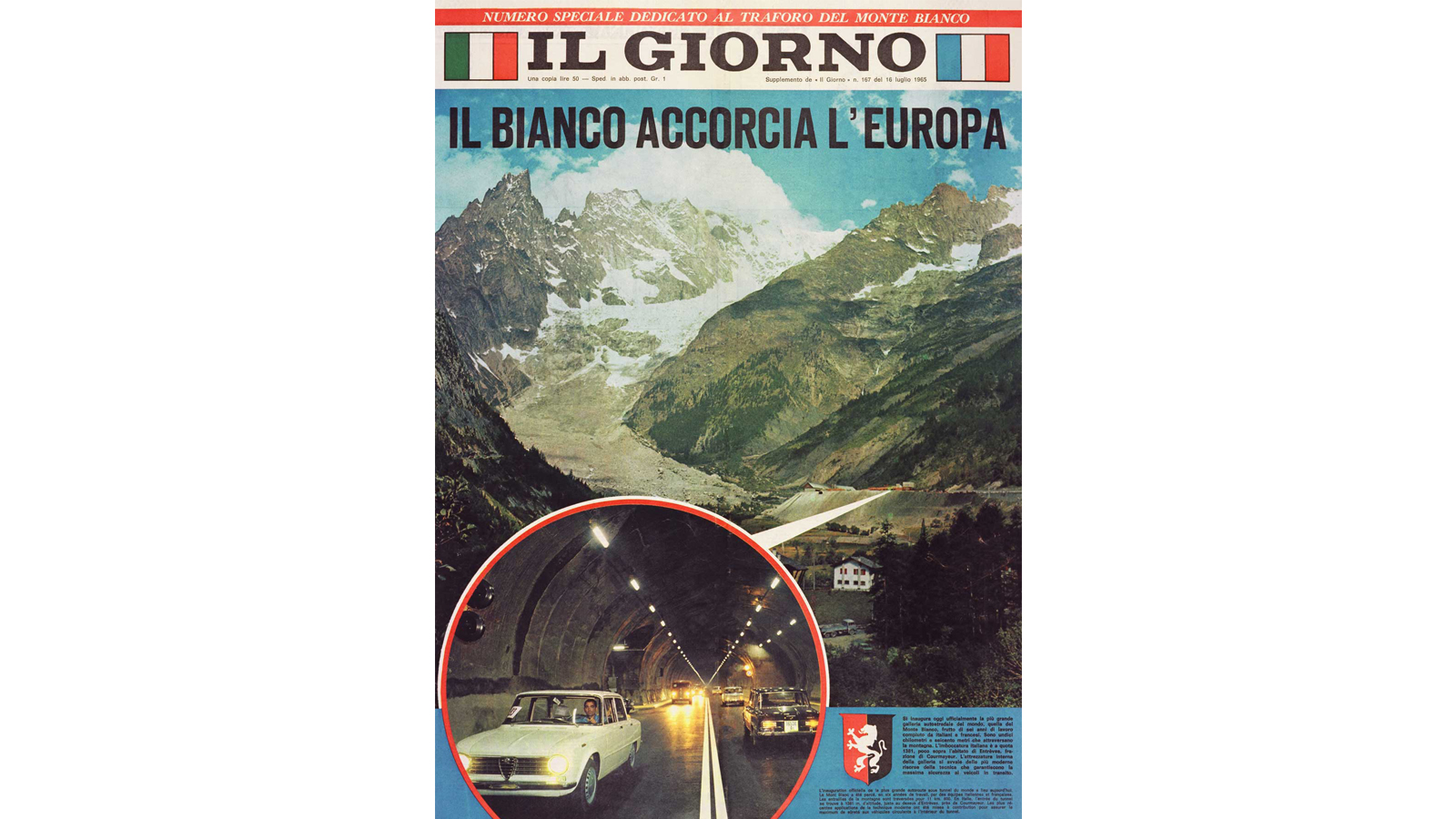
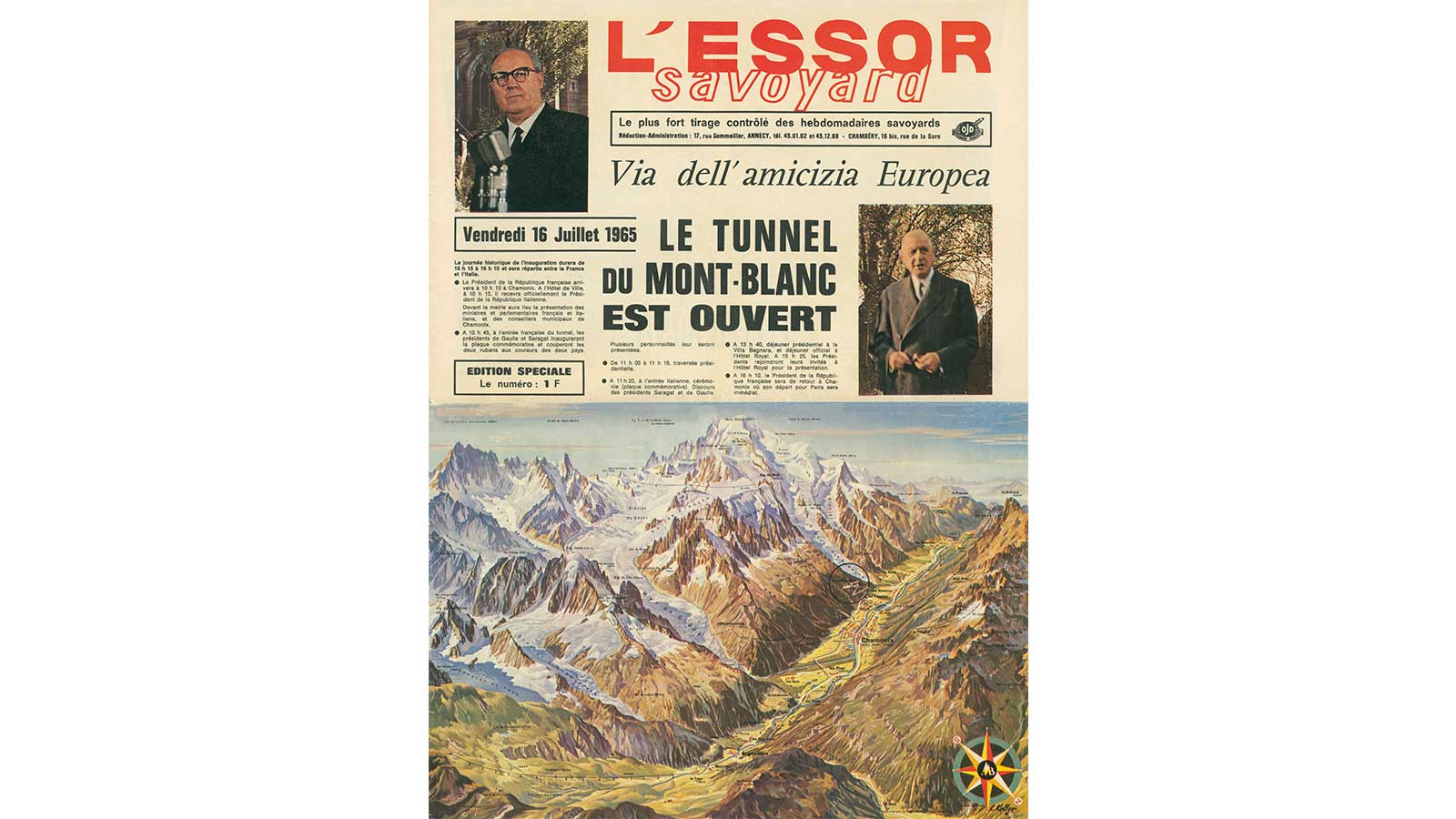
Historic crossings…
The first crossing of the Alps was that of Hannibal Barca’s Carthigian army, with some 50 000 soldiers, in 218BC, during the 2nd Punic war between Rome and Carthage. The incongruous presence of elephants, exotic animals for this glaciated landscape, has contributed to the immortalisation of the legend.
Two millenniums later, in 1800, Napoleon Bonaparte, then First Consul, made this perilous crossing, accompanied by 40 000 soldiers; the trip was no less testing not just on account of the extreme natural and climatic conditions, but also due to the transportation of heavy artillery equipment.
If these two great generals had challenged the mountain alongside their armies with ambitions of a military nature, other more peaceful conquerors had the thirst to surpass themselves and cross the alpine massif‘s natural barrier.
Two millenniums later, in 1800, Napoleon Bonaparte, then First Consul, made this perilous crossing, accompanied by 40 000 soldiers; the trip was no less testing not just on account of the extreme natural and climatic conditions, but also due to the transportation of heavy artillery equipment.
If these two great generals had challenged the mountain alongside their armies with ambitions of a military nature, other more peaceful conquerors had the thirst to surpass themselves and cross the alpine massif‘s natural barrier.
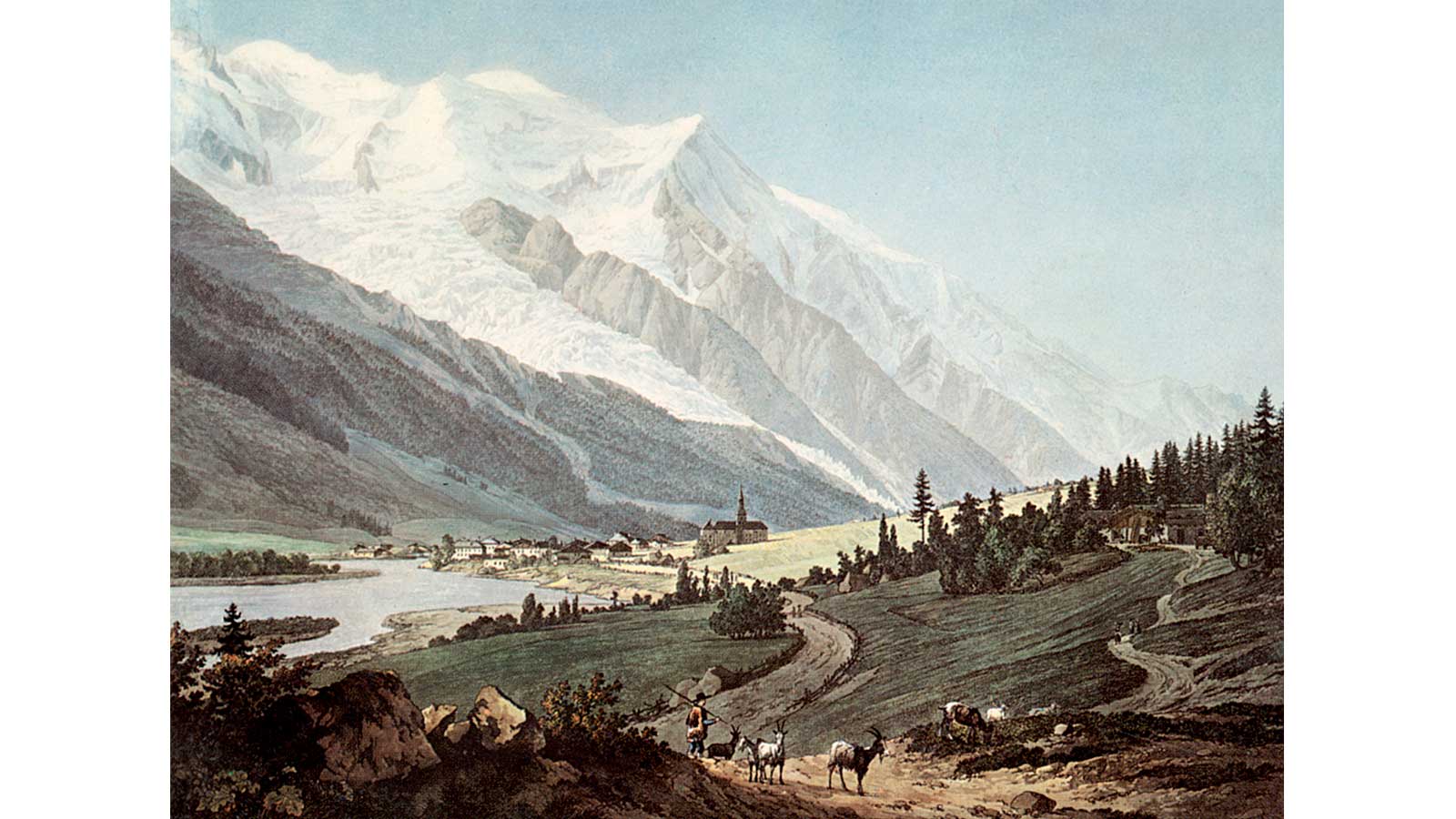
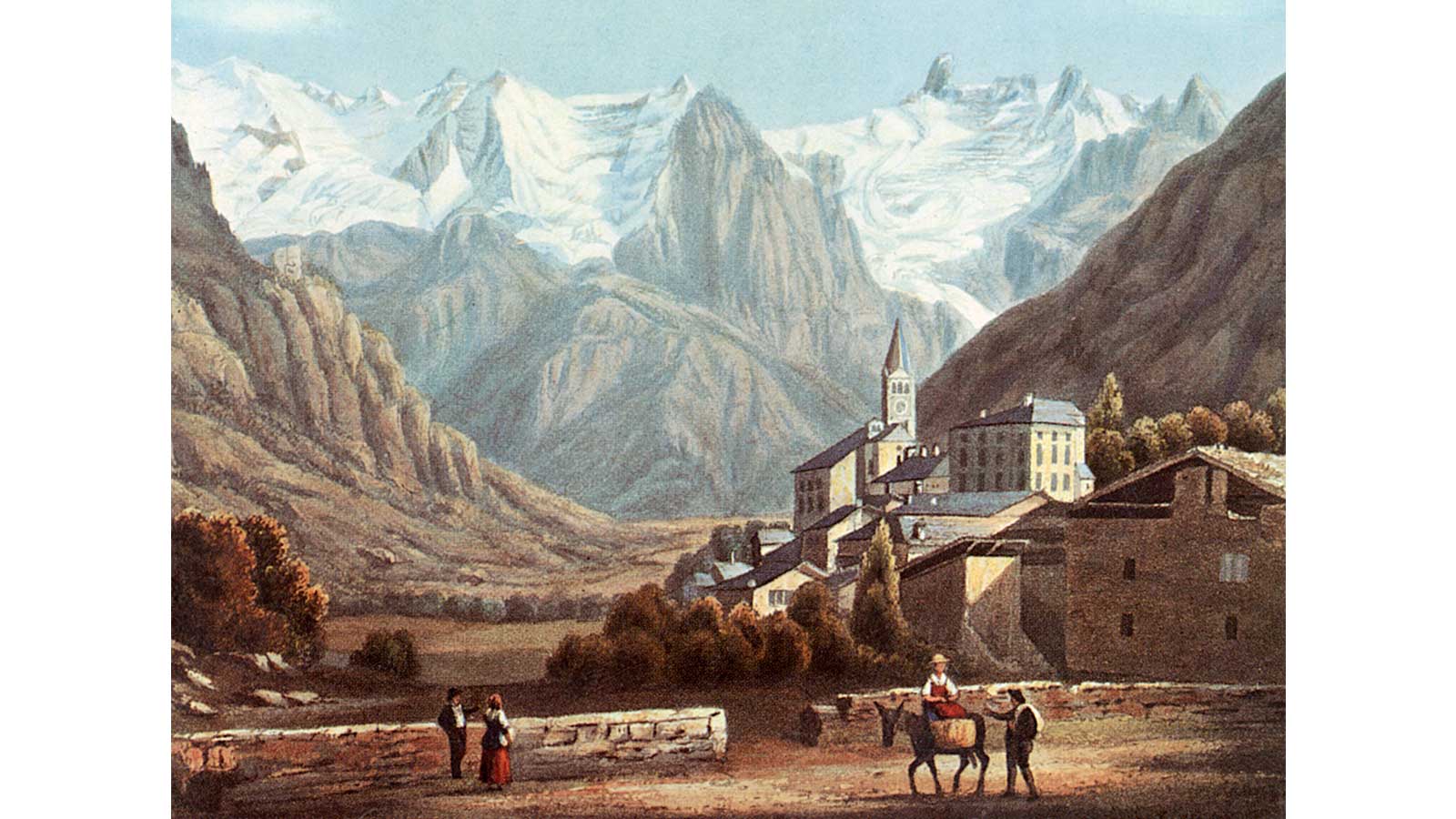
… to first ascensions!
The first to have, in 1786, reached the summit of Mont Blanc were Doctor Michel-Gabriel Paccard and guide Jacques Balmat, determined mountaineers from Chamonix.
They were closely followed by Horace-Bénédict du Saussure, a Swiss naturalist and physicist. At the end of his ascent this physicist exclaimed (and wrote in his memoirs) : "A day will come when we shall dig a cart track under Mont Blanc and these two valleys, the Valley of Chamonix and the Aosta Valley, will be united " …
They were closely followed by Horace-Bénédict du Saussure, a Swiss naturalist and physicist. At the end of his ascent this physicist exclaimed (and wrote in his memoirs) : "A day will come when we shall dig a cart track under Mont Blanc and these two valleys, the Valley of Chamonix and the Aosta Valley, will be united " …
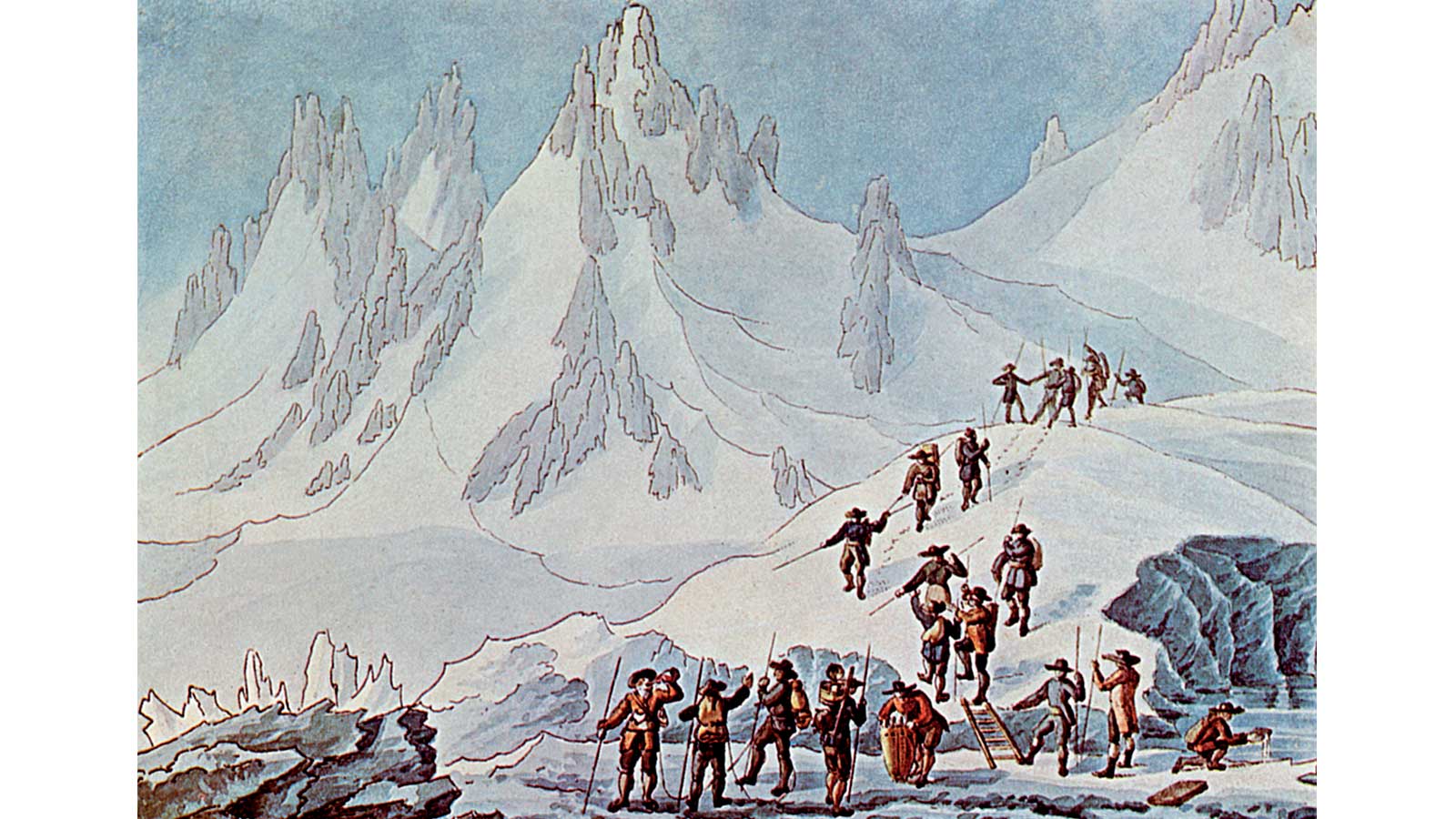
Numerous unachieved projects
The arrival of the industrial revolution and the evolution of means of transport saw the birth of new ambitions. Born though the will of Camille Cavour to link the two capitals of the Kingdom of Savoie, Turin et Chambéry, the boring of the Fréjus rail tunnel, launched with success in 1857, constituted a first underground axis of communication crossing the Alps.
This success nourished the desire to undertake other similar big works and to meet new technical challenges... However, the economic stakes, added to the real difficulties of access and drilling of a gallery under Mont- Blanc, delayed the execution of the work. All the projects developed during the 19th century, in homage to the novelties introduced by the use of the steam engine, were of railway nature.
As from 1882 several construction sites were successful and the first trains starting crossing through tunnels, notably between Switzerland and Italy, opening up an essential communication route between the two countries
In this auspicious context, and on the initiative of the Valdôtain deputy, Francesco Farinet, the project of Mont-Blanc returned to the foreground at the very beginning of the 20th century. The engineer Arnold Monod completed his excavation project and submitted it to a delegation of the Italian and French Parliament, supported by the First Ministers Giolitti and Clémenceau in a visit to Aosta in 1908.
This success nourished the desire to undertake other similar big works and to meet new technical challenges... However, the economic stakes, added to the real difficulties of access and drilling of a gallery under Mont- Blanc, delayed the execution of the work. All the projects developed during the 19th century, in homage to the novelties introduced by the use of the steam engine, were of railway nature.
As from 1882 several construction sites were successful and the first trains starting crossing through tunnels, notably between Switzerland and Italy, opening up an essential communication route between the two countries
In this auspicious context, and on the initiative of the Valdôtain deputy, Francesco Farinet, the project of Mont-Blanc returned to the foreground at the very beginning of the 20th century. The engineer Arnold Monod completed his excavation project and submitted it to a delegation of the Italian and French Parliament, supported by the First Ministers Giolitti and Clémenceau in a visit to Aosta in 1908.
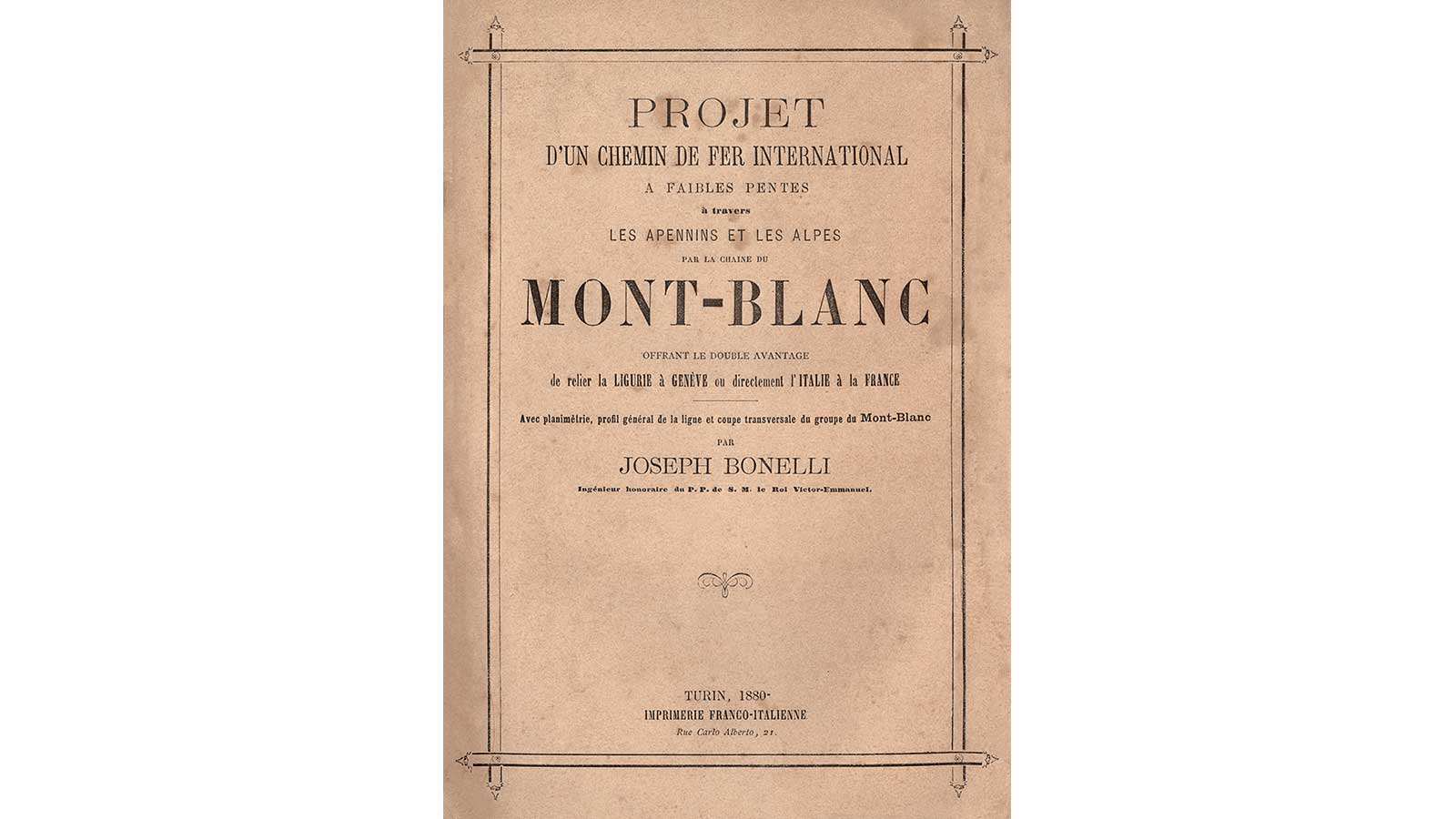
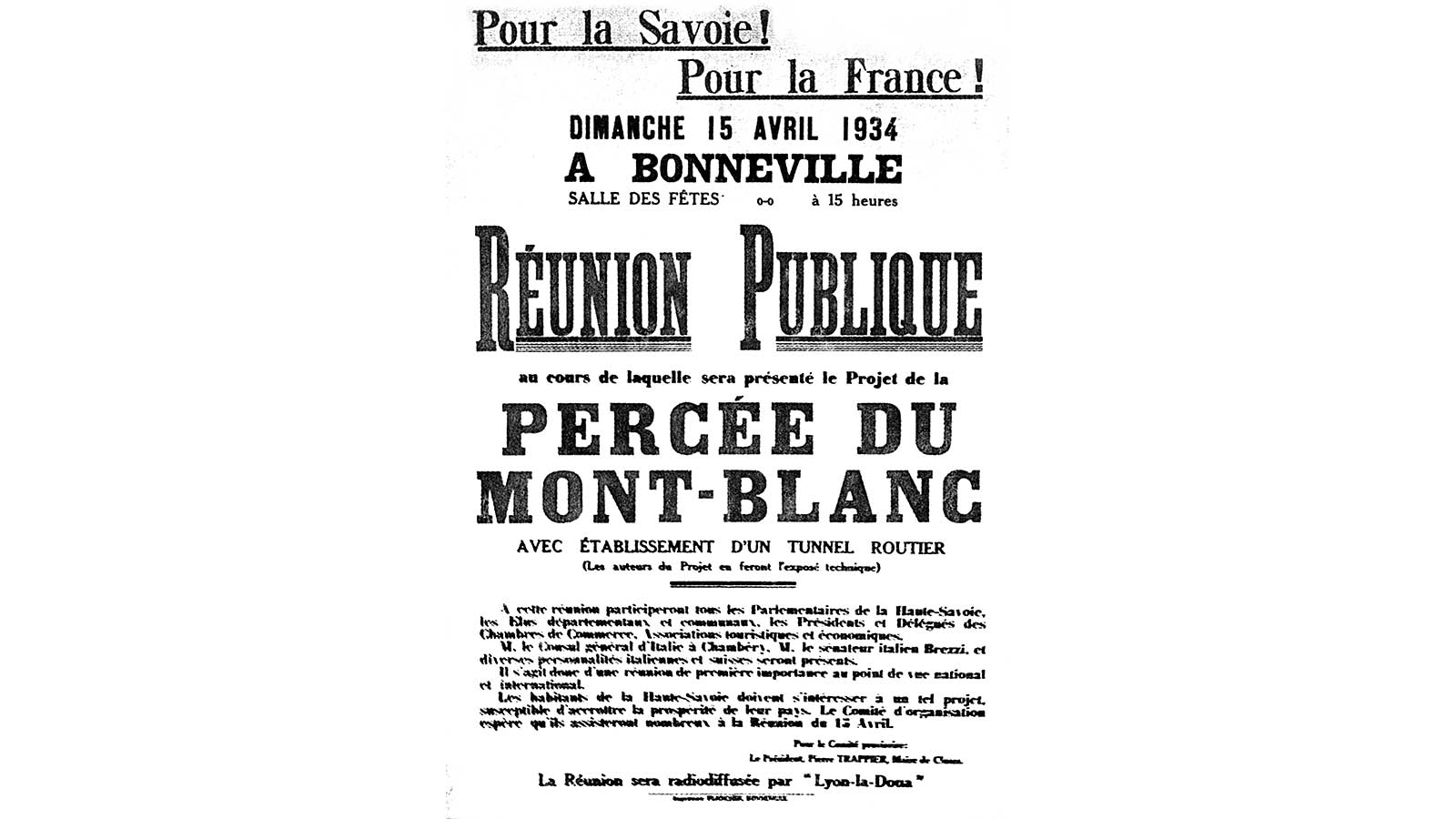
Monod’s avant-garde study slowed down by international conflicts
Arnold Monod presented the first thorough technical and geological study, the basis for later projects. The upheaval on the French and Italian political scene, the war in Libya and the imminent world conflict relegated these works to the background: such a symbol of union between the people and nations no longer held a place of importance in this disrupted period. Besides, the Fréjus, Saint-Gothard and Simplon no longer justified, on an economic plan, the construction of an additional tunnel under Mont Blanc.
In 1934, during a conference between the French, Italian and Swiss authorities at Bonneville, Arnold Monod put the drilling of the Tunnel of Mont-Blanc back under the spotlight and explained a new project: a road gallery of 12.62km, a double tube and with a physical separation for the direction of traffic, reserved for vehicles with combustion engines. He even estimated the volume of traffic and the cost of the toll. The popular enthusiasm generated for this plan was soon dampened by a new deterioration of the political climate between France and Italy, precursor of the troubles which led to the outbreak of World War Two…
In 1934, during a conference between the French, Italian and Swiss authorities at Bonneville, Arnold Monod put the drilling of the Tunnel of Mont-Blanc back under the spotlight and explained a new project: a road gallery of 12.62km, a double tube and with a physical separation for the direction of traffic, reserved for vehicles with combustion engines. He even estimated the volume of traffic and the cost of the toll. The popular enthusiasm generated for this plan was soon dampened by a new deterioration of the political climate between France and Italy, precursor of the troubles which led to the outbreak of World War Two…
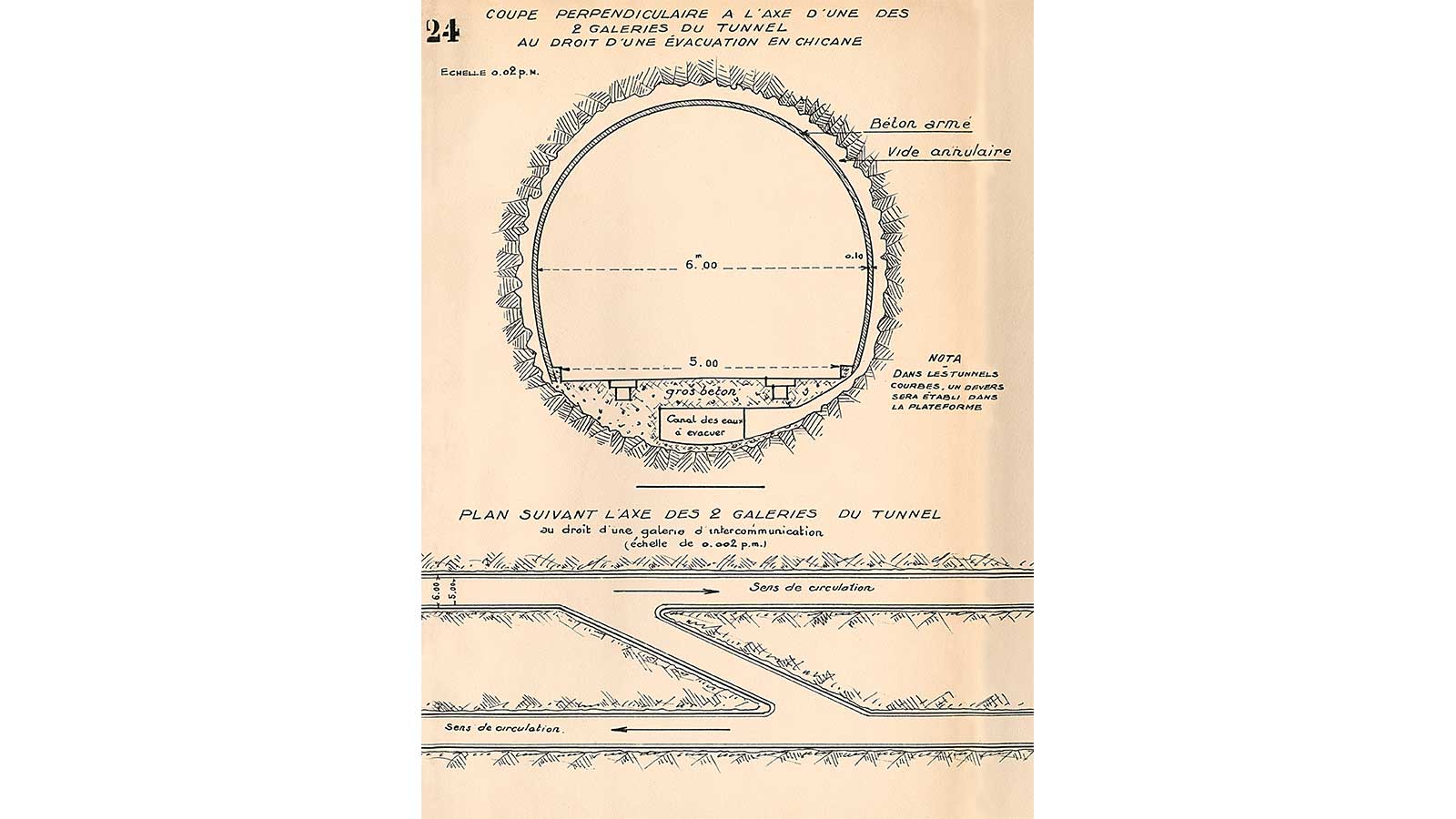
"The Lora Totino opening: the vision of an audacious man, the beginnings of the current Tunnel
It wasn’t until after the end of the conflict, in 1946, that Count Dino Lora Totino, an engineer from the Piedmont region, launched, under his own name and at his cost, the drilling the tunnel from the Italian side.
On the French side, the town of Chamonix had also granted him twenty hectares of ground for surveying, but a year later the Count was ordered to stop his activities by Italian political and military authorities. At that time (1947) the gallery had reached the length of around 260 metres.
In spite of the failure, this private initiative had nevertheless put the question of the drilling of a tunnel under Mont-Blanc back on to the agenda. But it was necessary to wait until 1949 for the constitution of the Franco-Italian « Intergovernmental Commission » before the Mont-Blanc Tunnel was formalised. It was not until March 1953 that an International Convention for the construction of the tunnel was approved. Undersigned by the ambassadors of both the Countries, it was put to the vote of both the Italian and French Parliaments. This charter was ratified in Italian parliament in 1954 and by that of the French in 1957.
On the French side, the town of Chamonix had also granted him twenty hectares of ground for surveying, but a year later the Count was ordered to stop his activities by Italian political and military authorities. At that time (1947) the gallery had reached the length of around 260 metres.
In spite of the failure, this private initiative had nevertheless put the question of the drilling of a tunnel under Mont-Blanc back on to the agenda. But it was necessary to wait until 1949 for the constitution of the Franco-Italian « Intergovernmental Commission » before the Mont-Blanc Tunnel was formalised. It was not until March 1953 that an International Convention for the construction of the tunnel was approved. Undersigned by the ambassadors of both the Countries, it was put to the vote of both the Italian and French Parliaments. This charter was ratified in Italian parliament in 1954 and by that of the French in 1957.
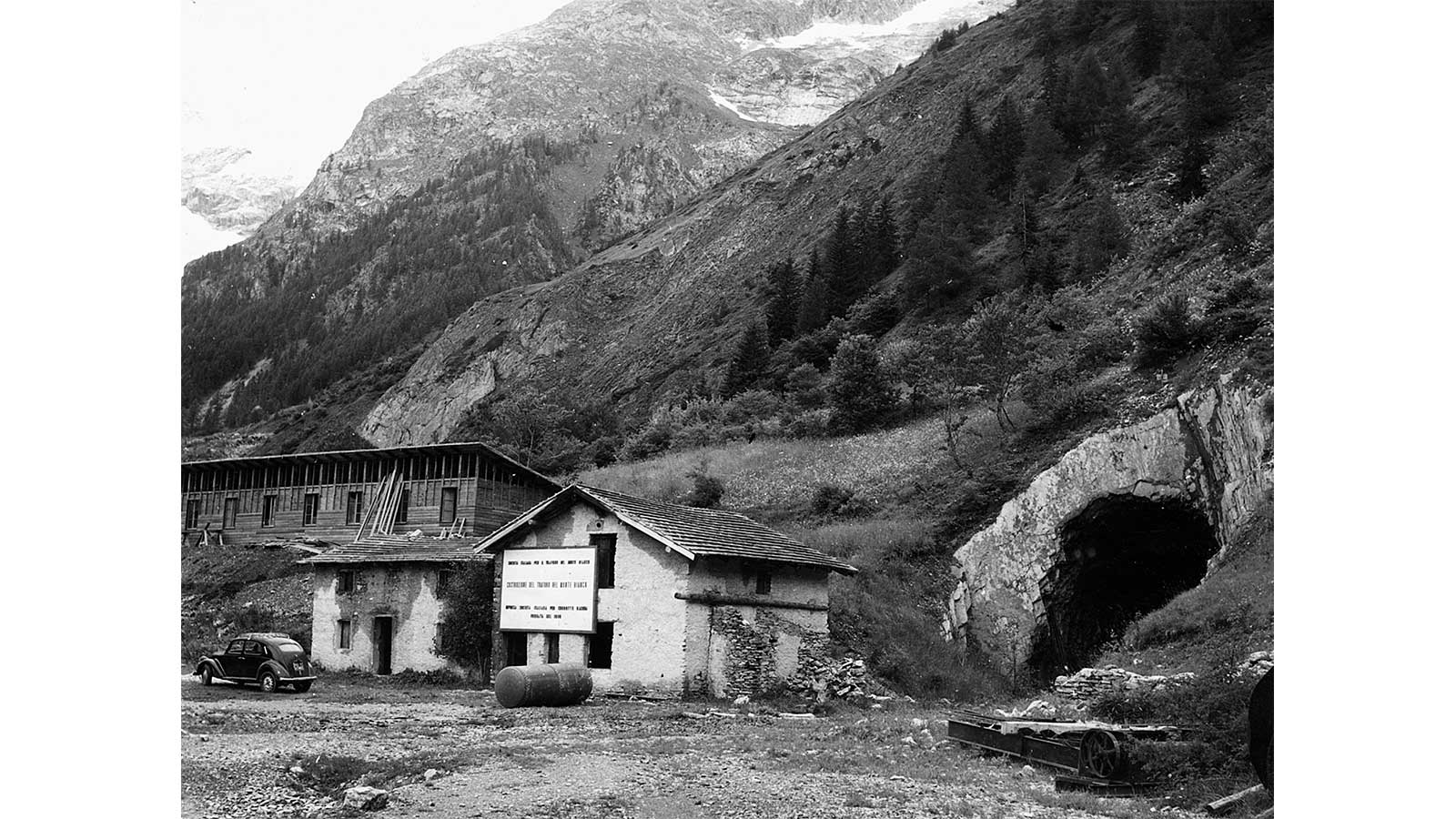
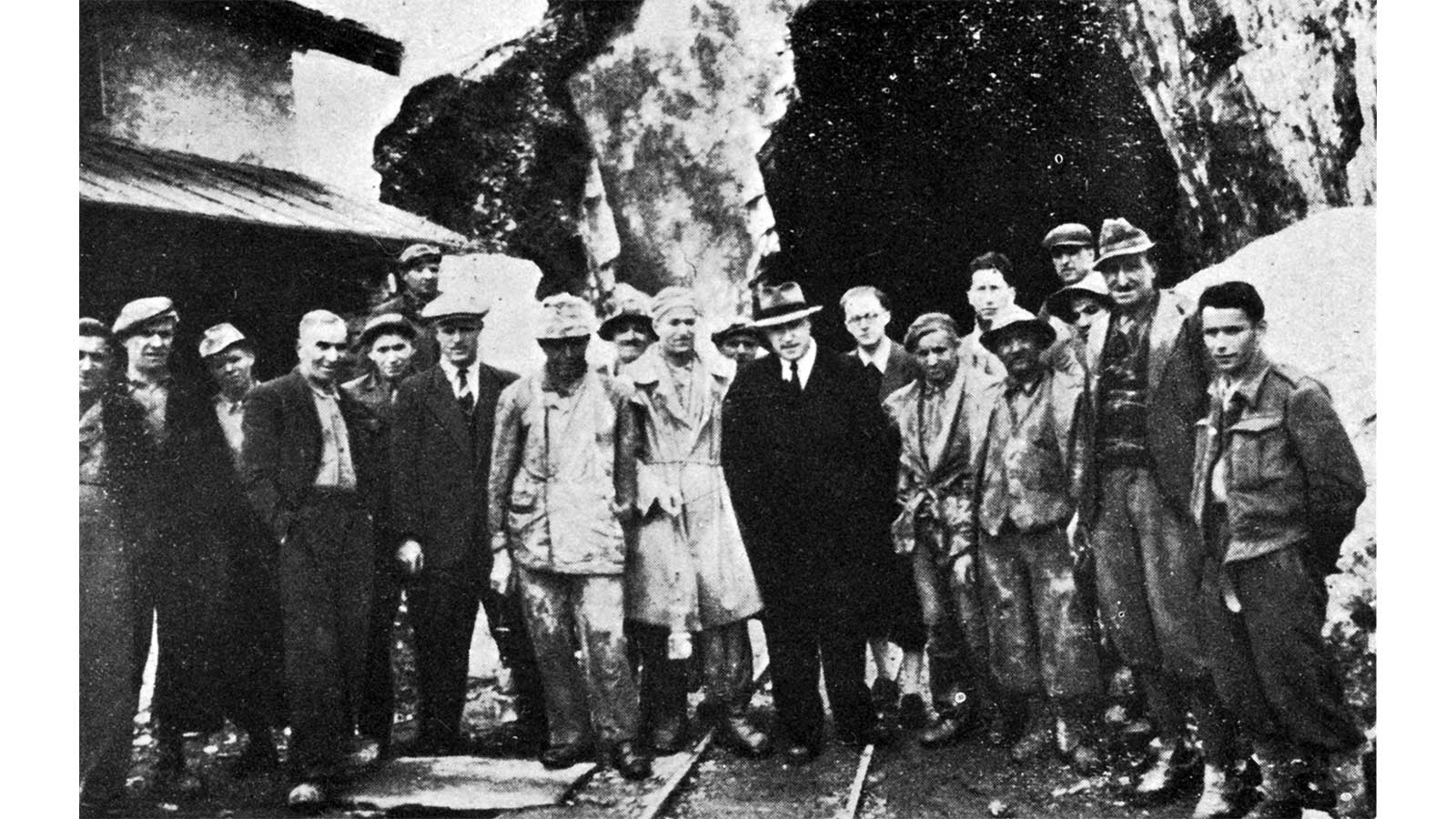
1959-1962: Digging the gallery: a technical challenge carried out by brave men
The ratifications, Italian and then French, of the international convention allowed the two States to form companies for the construction and exploitation of the tunnel: the "Società Italiana per Azioni per il Traforo del Monte Bianco" was constituted in 1957 in Aosta; a year later the French company was formed.
The necessary triangulations to define the route were carried out in the high mountain, despite notable difficulties, by the brilliant Italian surveyor Pietro Alaria: he had to work in extreme climatic conditions and at considerable altitudes.
The necessary triangulations to define the route were carried out in the high mountain, despite notable difficulties, by the brilliant Italian surveyor Pietro Alaria: he had to work in extreme climatic conditions and at considerable altitudes.
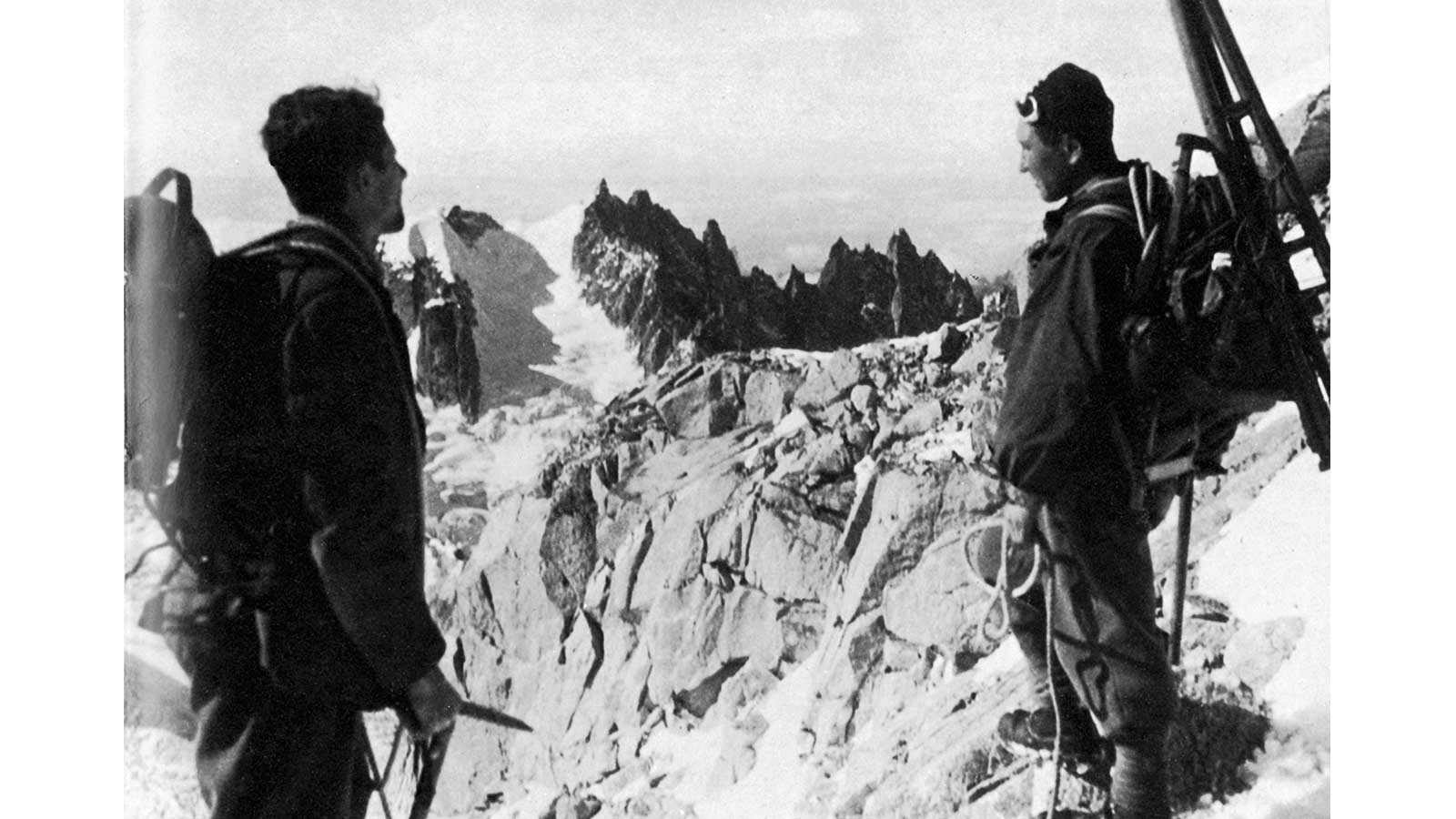
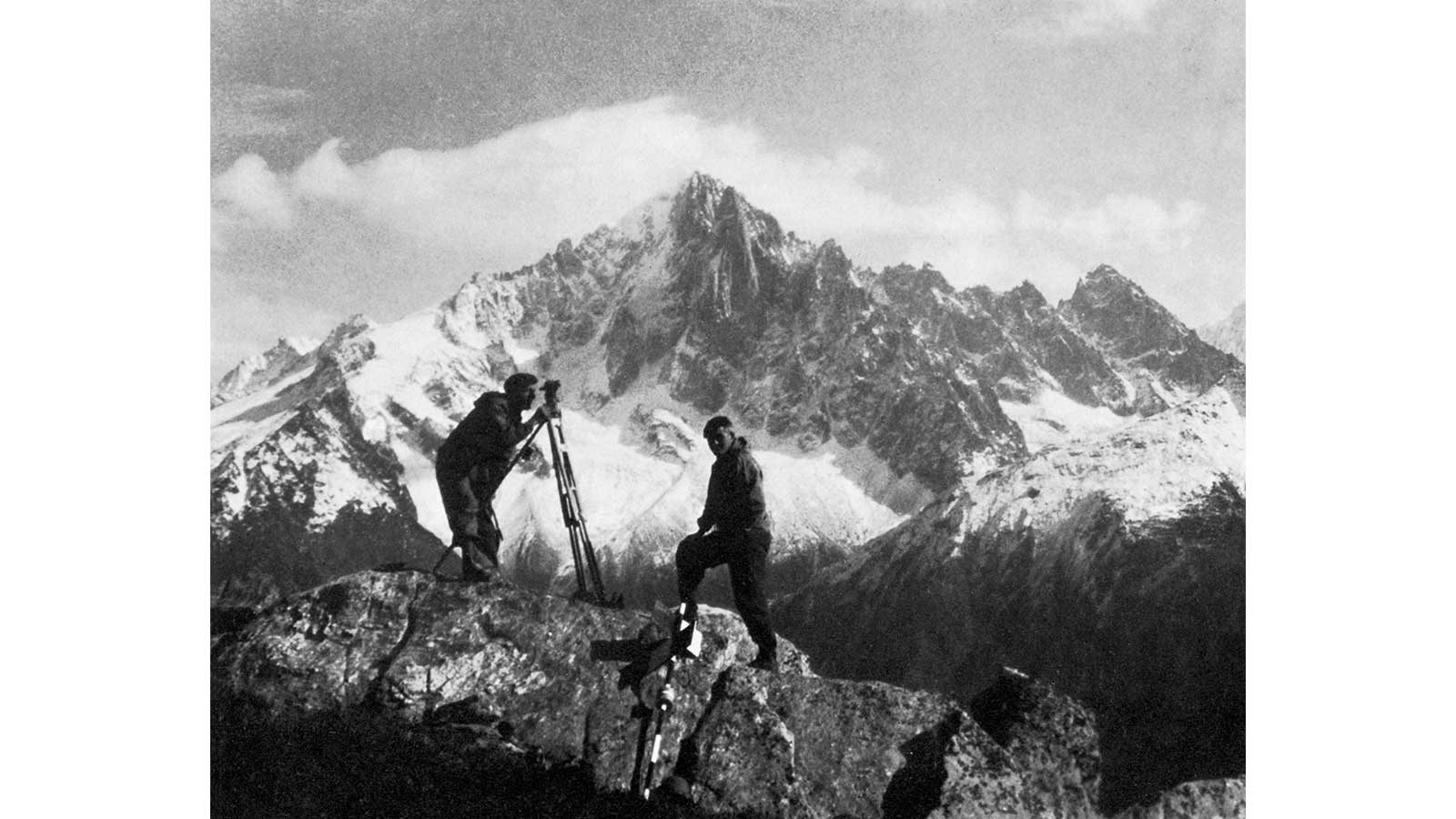
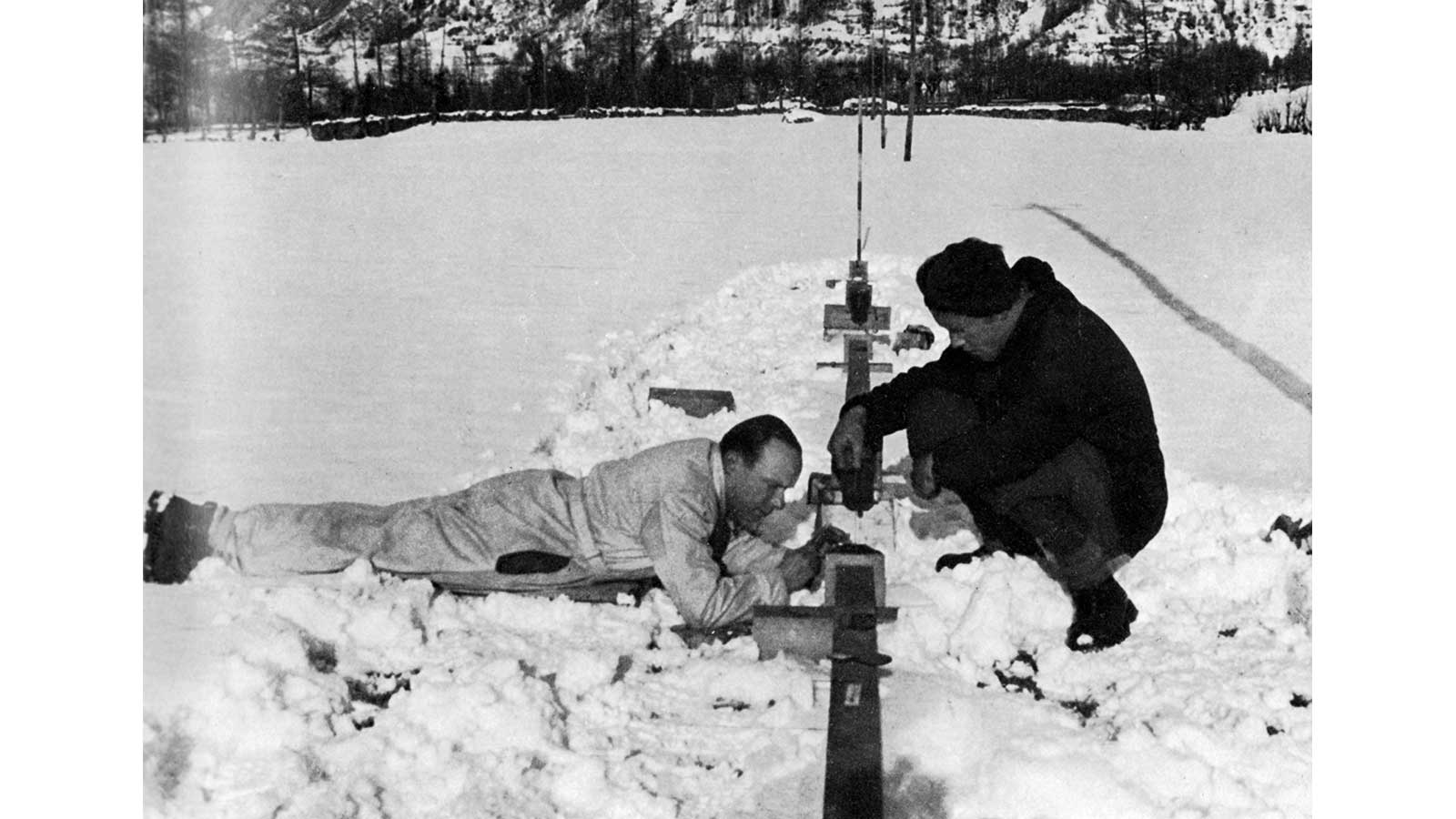
The work was launched in 1959, as from January on the Italian side and June from the French side. Each of the two excavation companies had to complete 5 800 metres of the gallery.
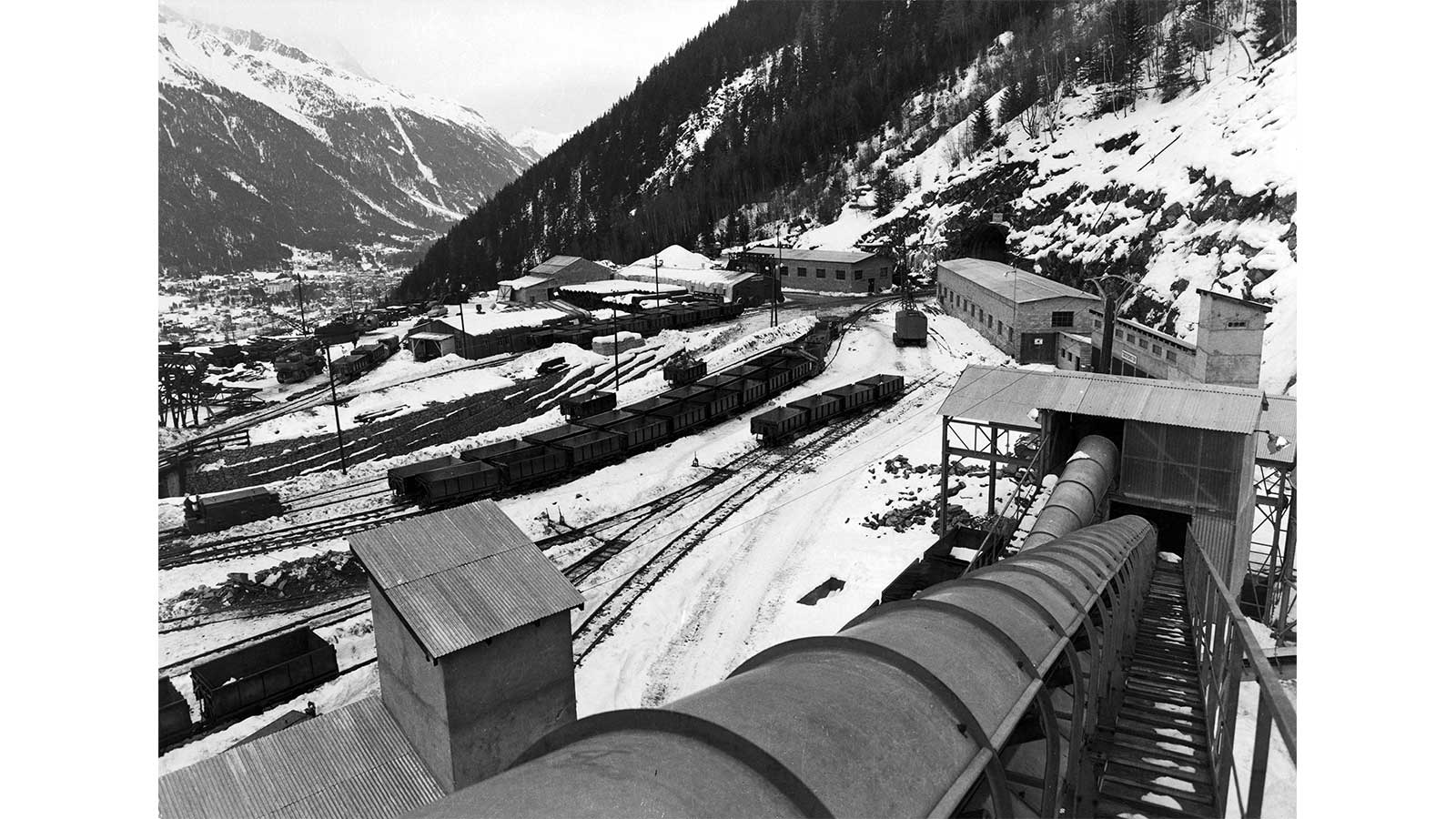
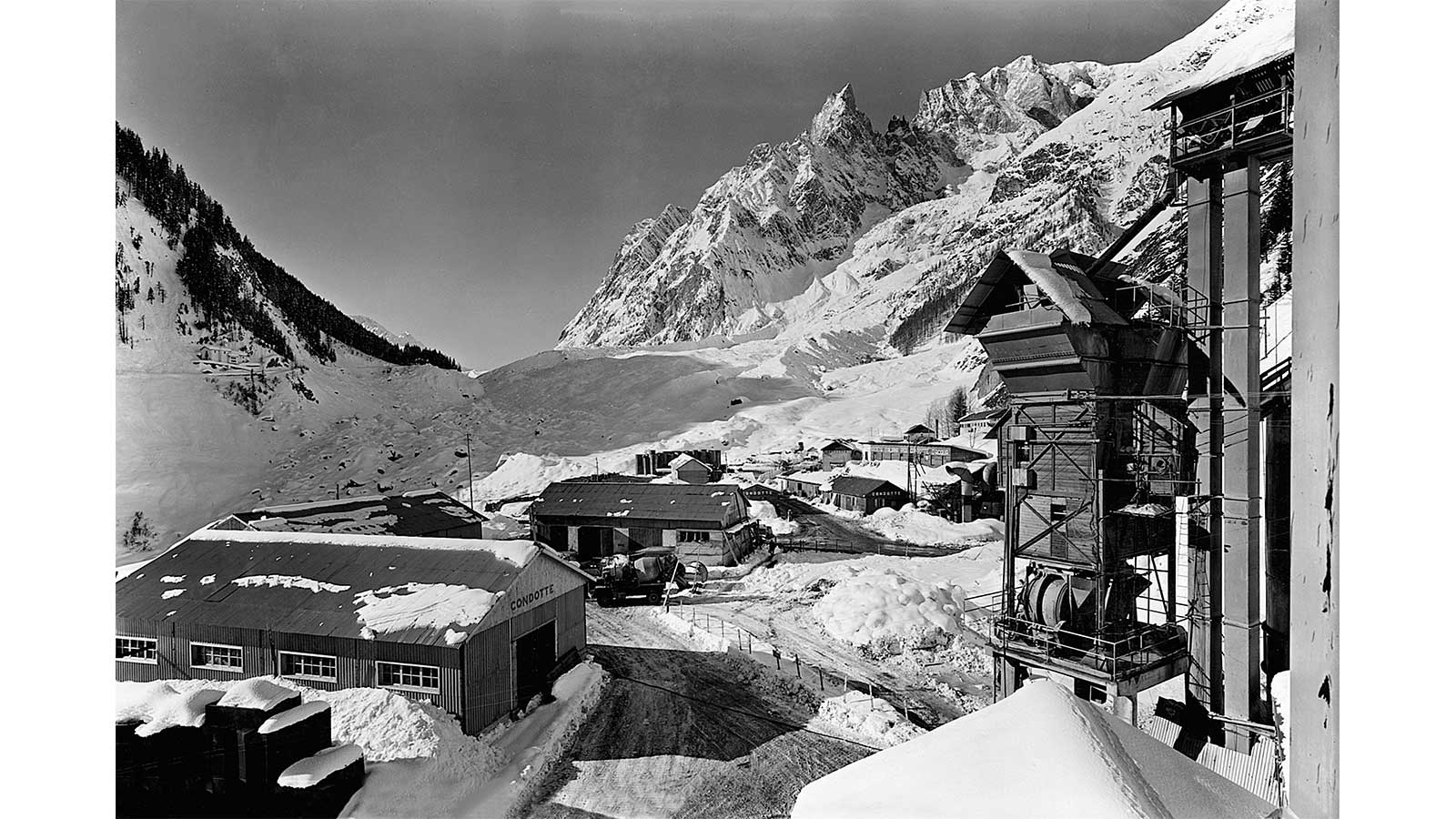
During this titanic task, the men were aided by the « Jumbo »: a gigantic machine, a type of scaffolding on rails, weighing 100 tonnes and carrying 16 perforating drills mounted 4 different levels. The holes were drilled to a length of 4 metres and then were packed with explosives. Almost a million cubic metres of rocky material was extracted from the depths of the mountain. One thousand two hundred tonnes of explosives were used for 400 000 blasts. The ceiling and the walls were covered in 200 000m3 of concrete. Subject to a phenomenon of decompression, some 235 000 bolts were necessary to consolidate the granite.
Twenty-three men lost their lives during the forty-four months of work: fourteen workmen from the Italian side, seven workmen from the French side and two mountain guides who disappeared during the preliminary triangulation exercises.
Twenty-three men lost their lives during the forty-four months of work: fourteen workmen from the Italian side, seven workmen from the French side and two mountain guides who disappeared during the preliminary triangulation exercises.
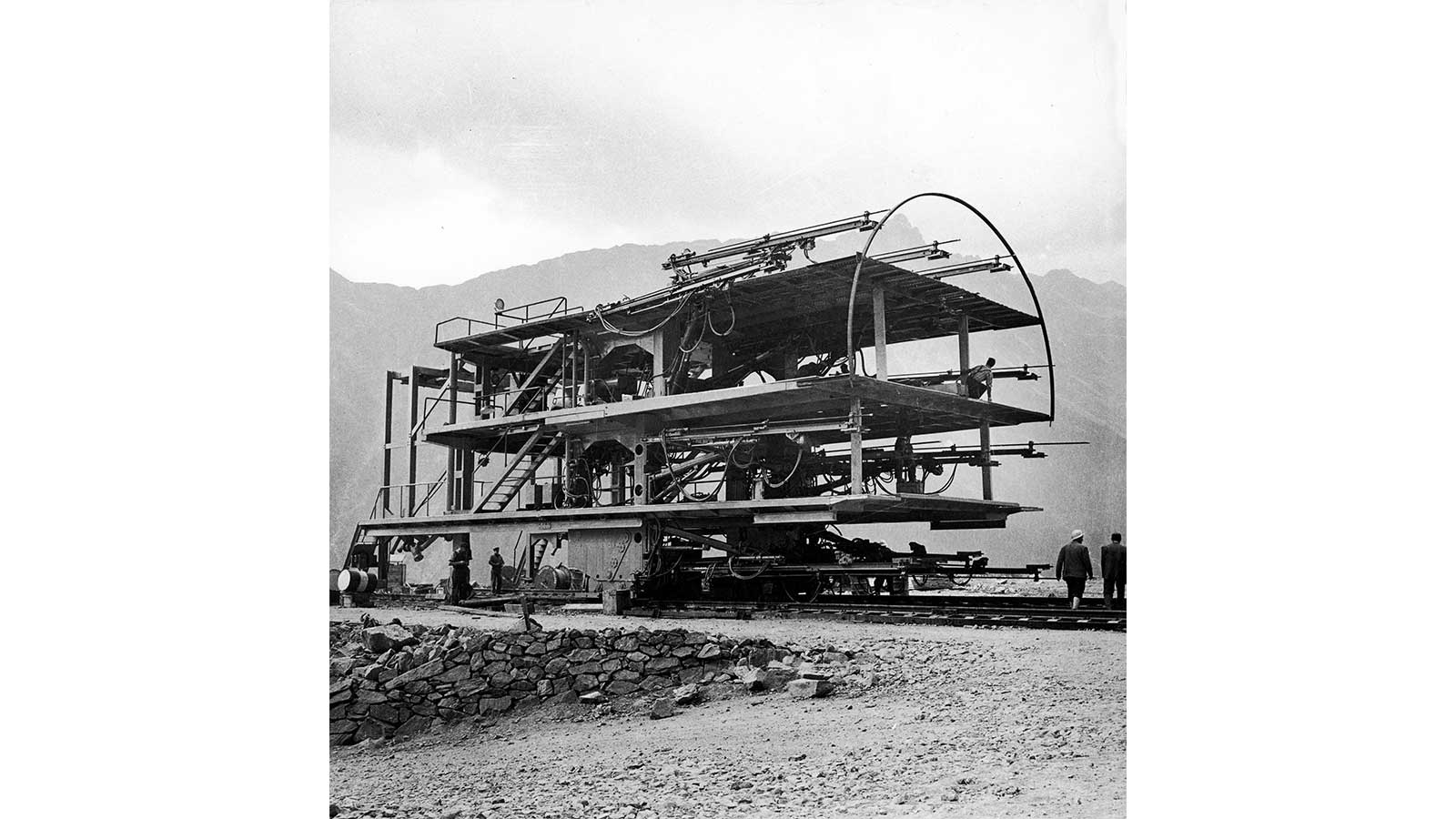
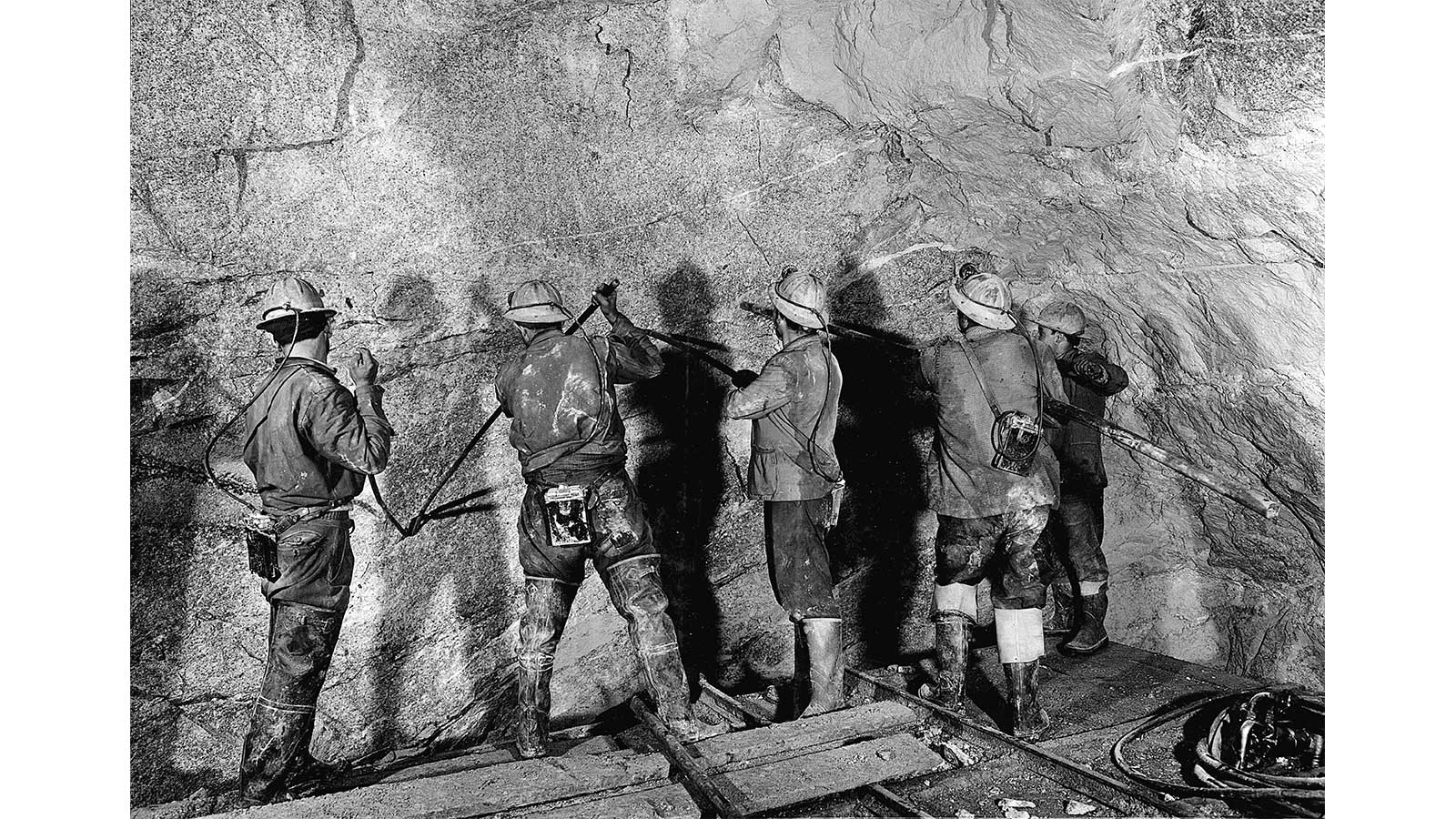
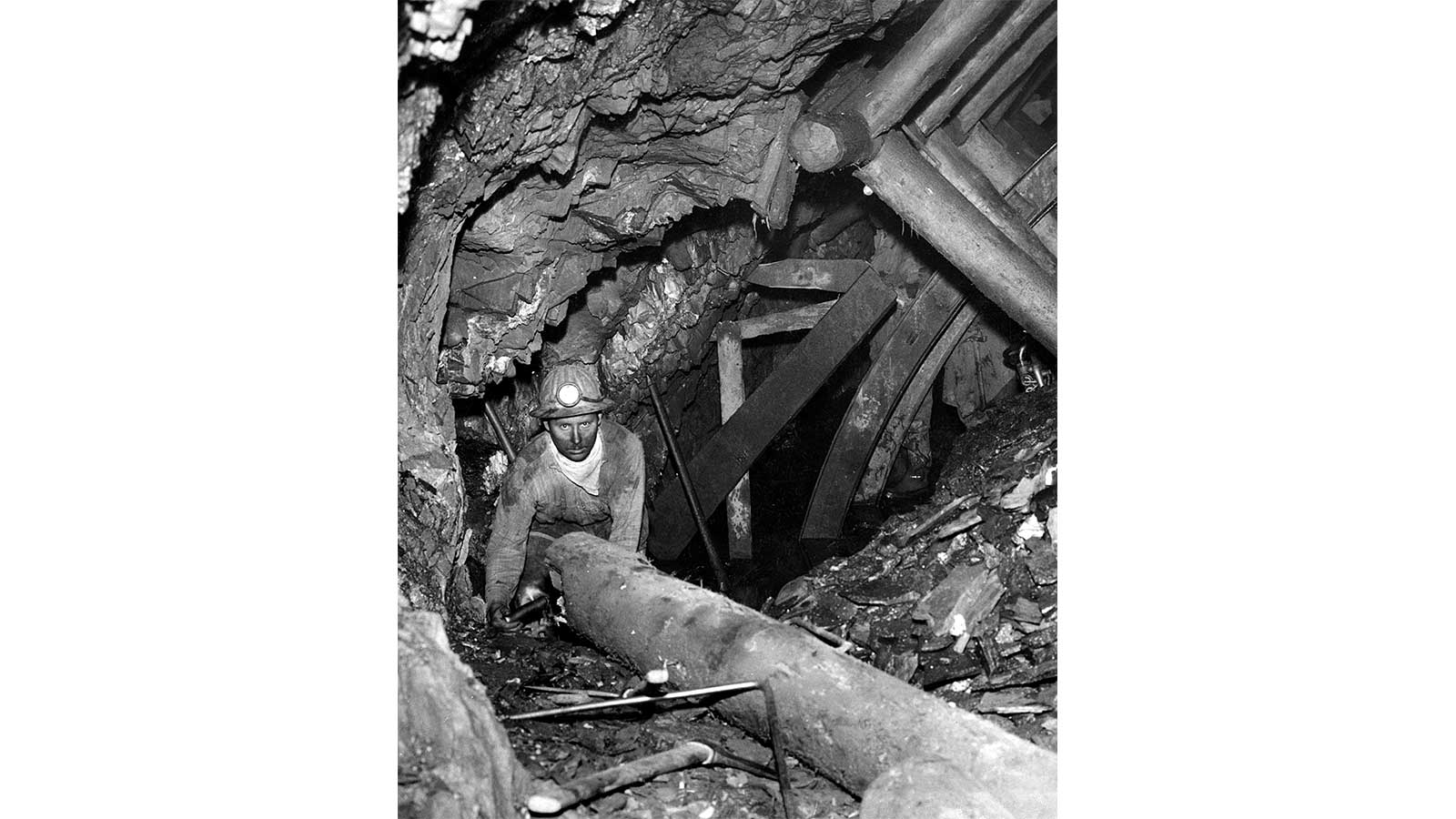
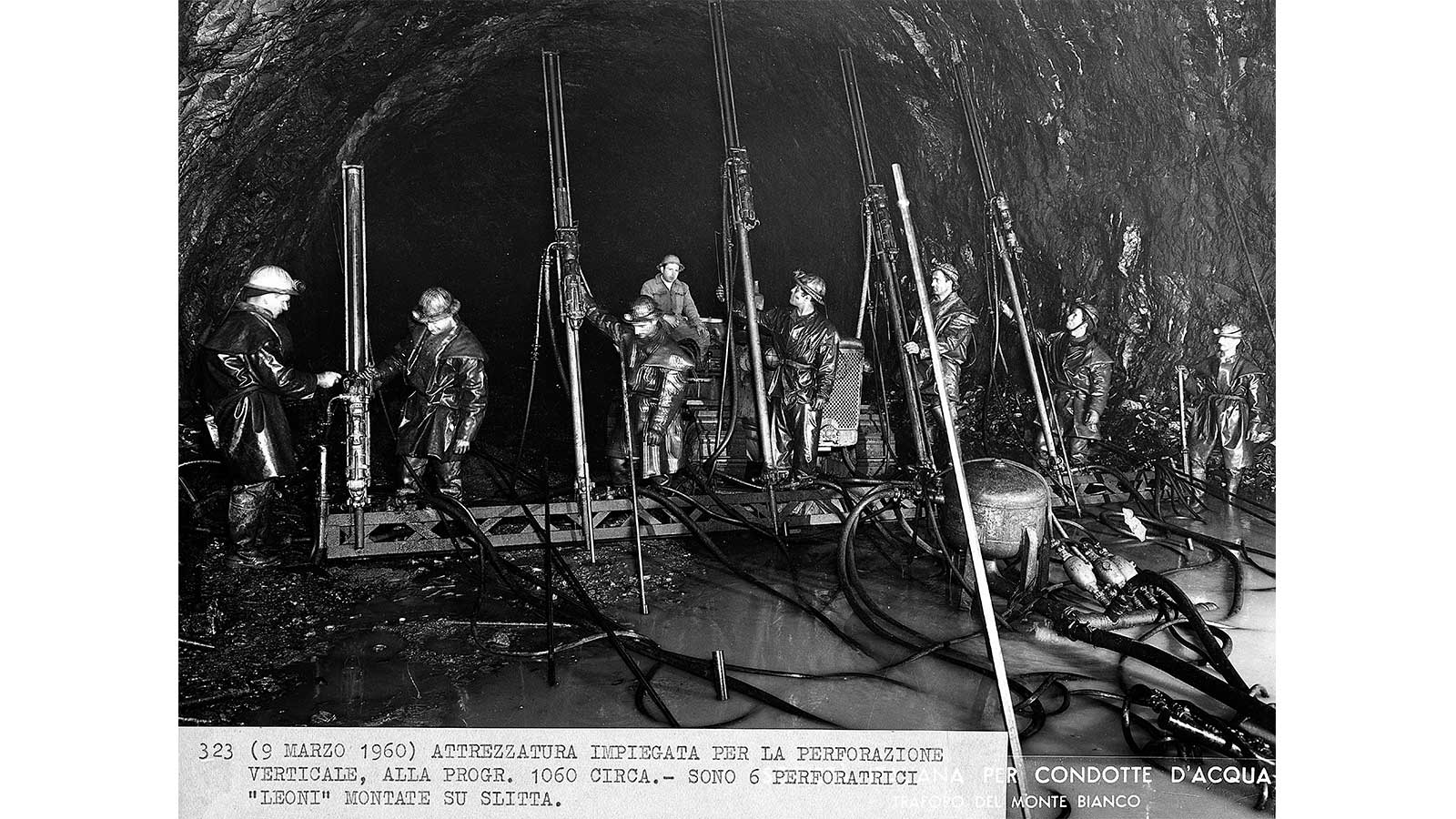
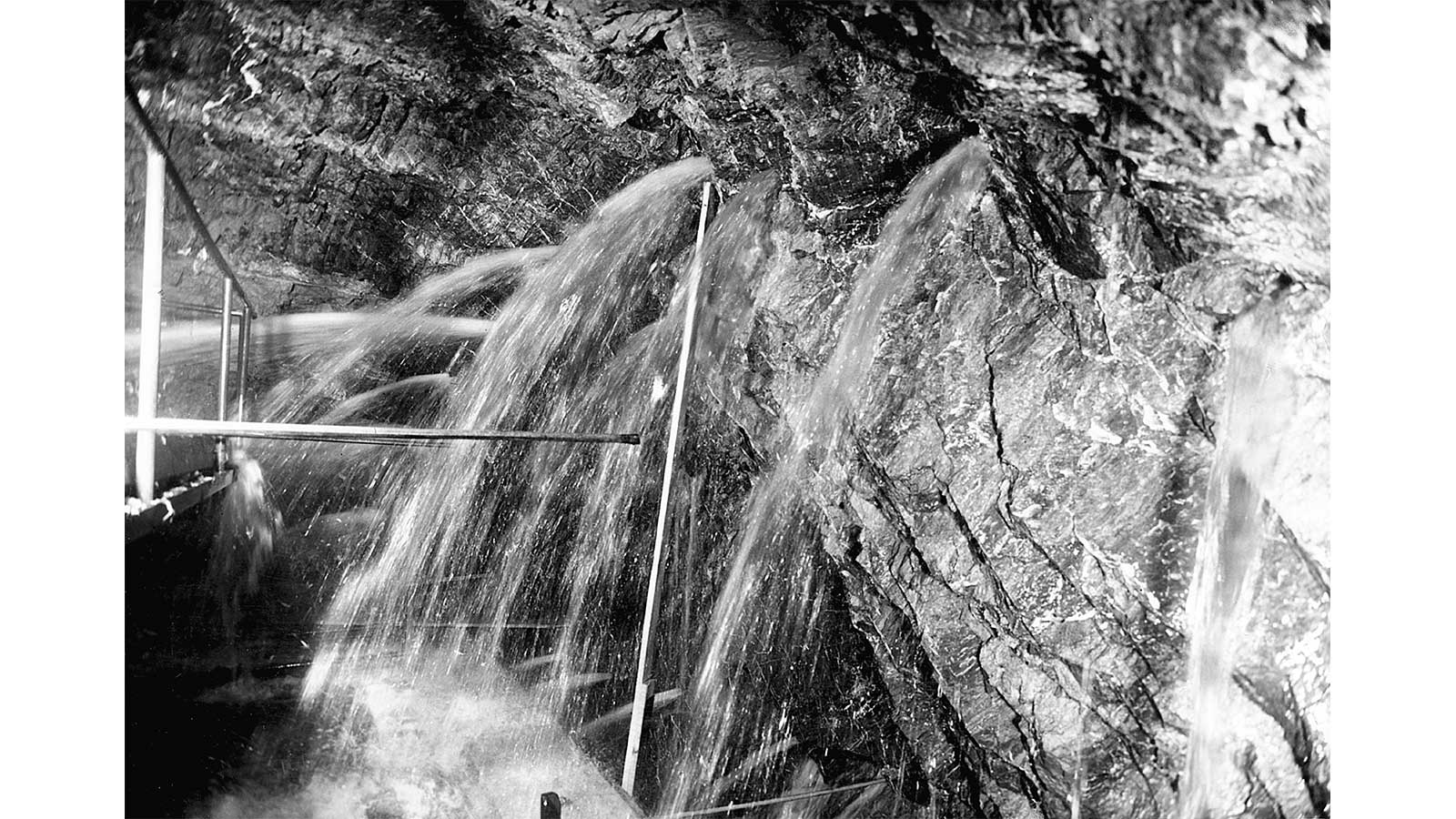
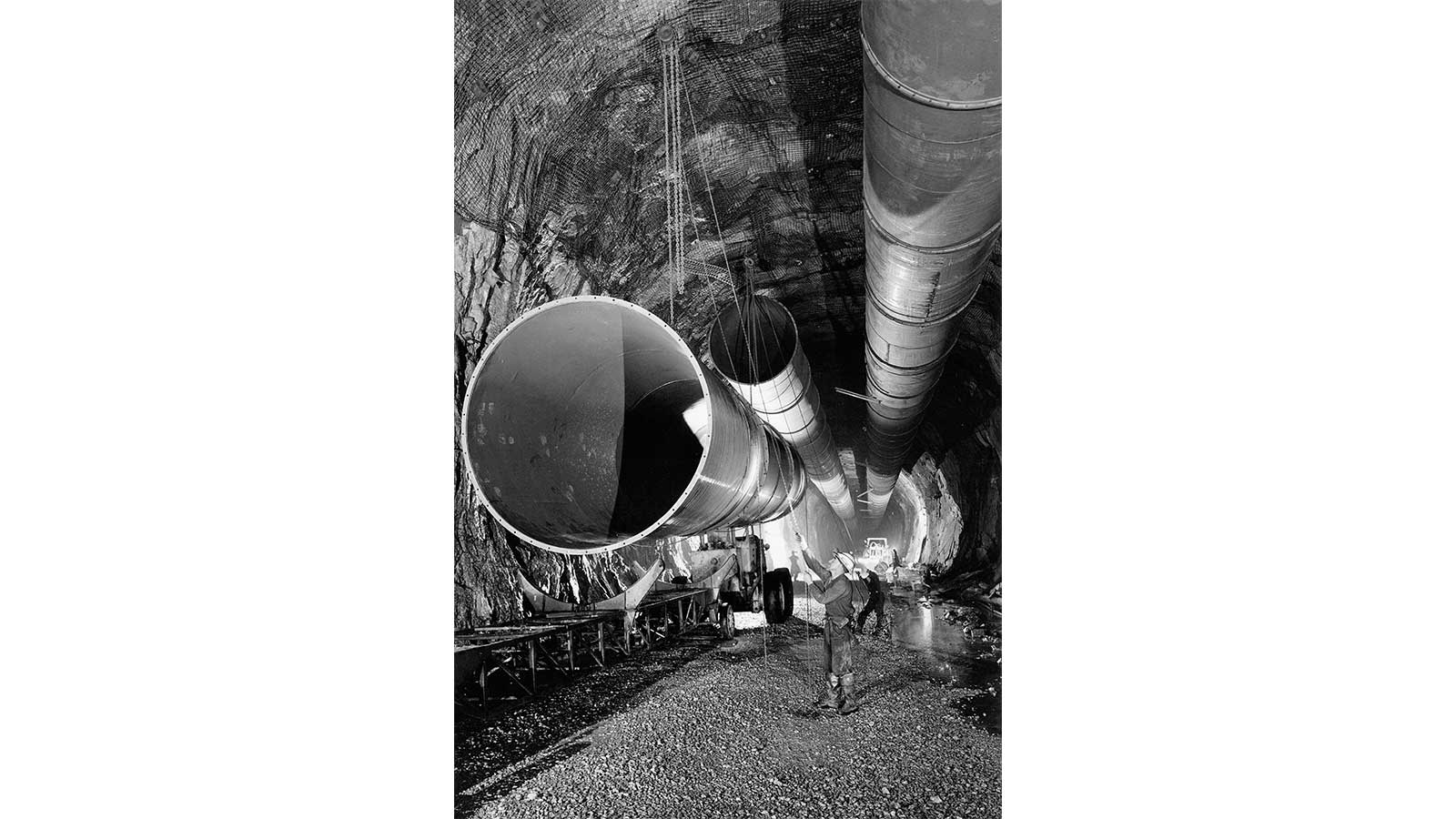
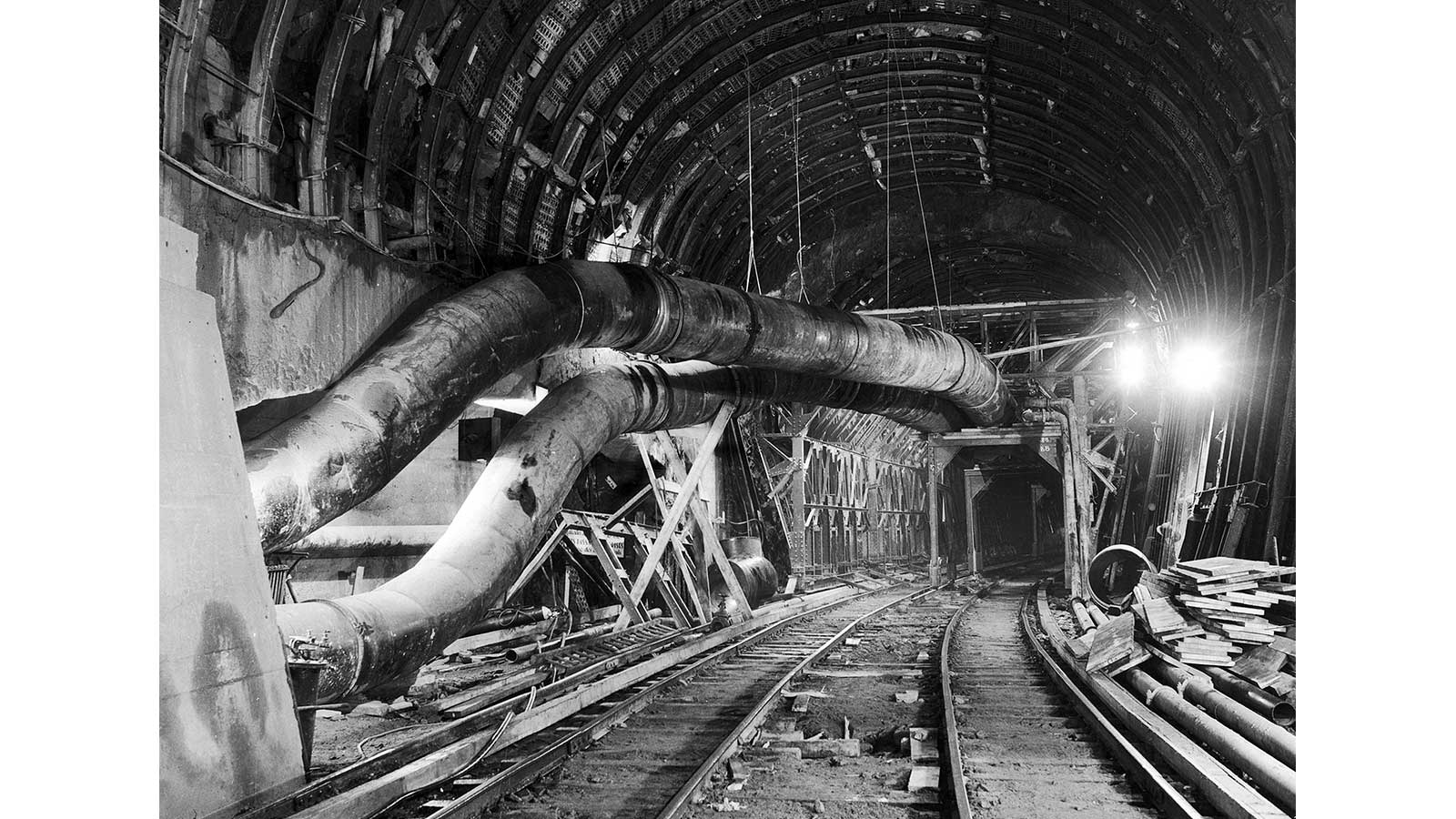
August 14th, 1962: a Franco-Italian meeting under Mont-Blanc
Bear in mind the technology of the era, as well as more than three years’ effort and the gigantic amount of work necessary. The last metres were drilled between May and July 1962. The aim of the 5800 metres was reached by the Italian team on August 3rd, 1962 and eleven days later, on August 14th at exactly 11:31, the last rock which separated the two workforces was cleared with an ultimate explosion. The Italian and French were finally united at the completion of a true exploit: the difference between the axes of the two galleries was barely 13 centimetres!
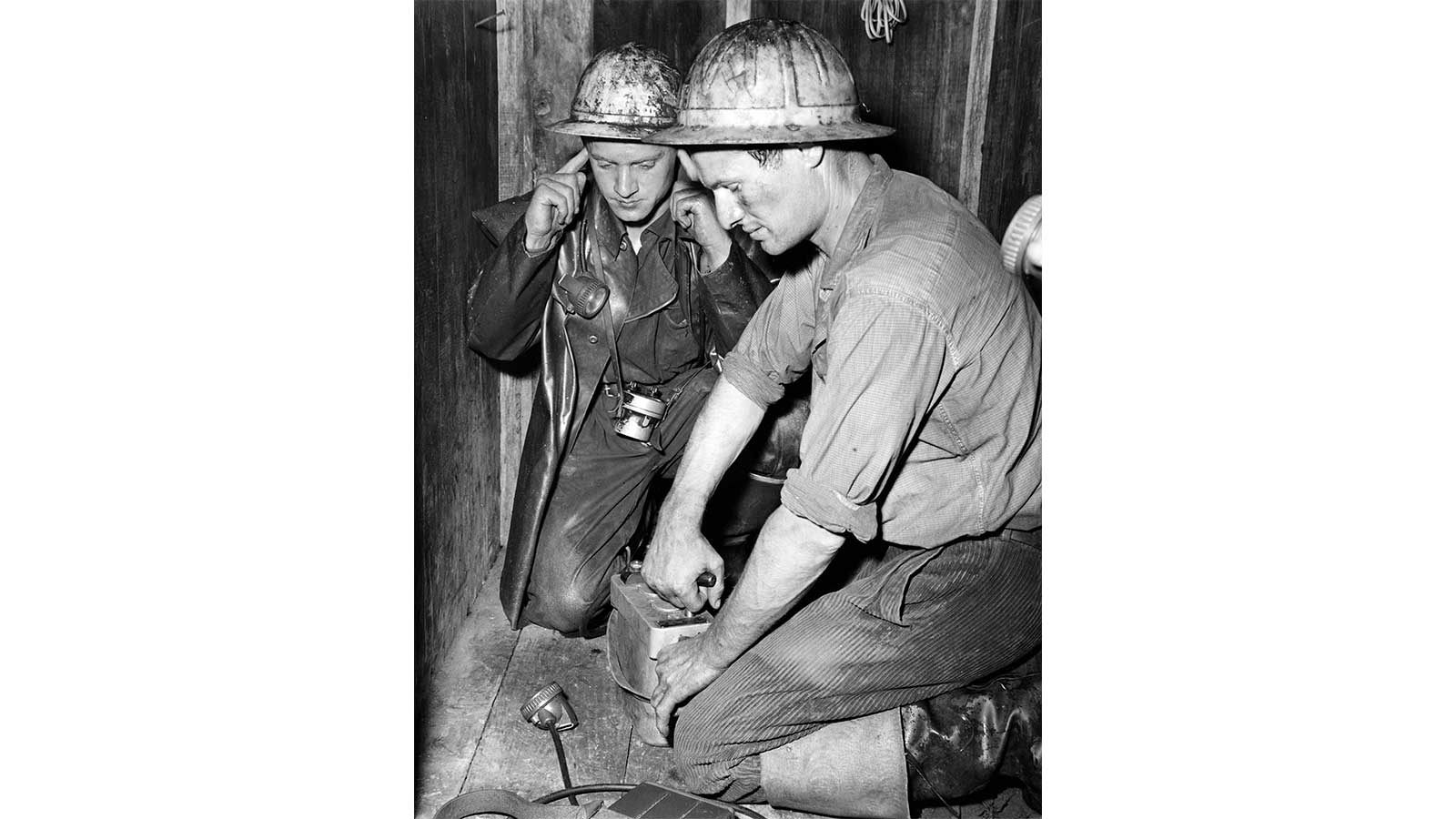
The workmen wild with emotion hugged each other and exchanged flags. They were found several hours later in the streets of Chamonix and Courmayeur inviting the public to share their celebrations.
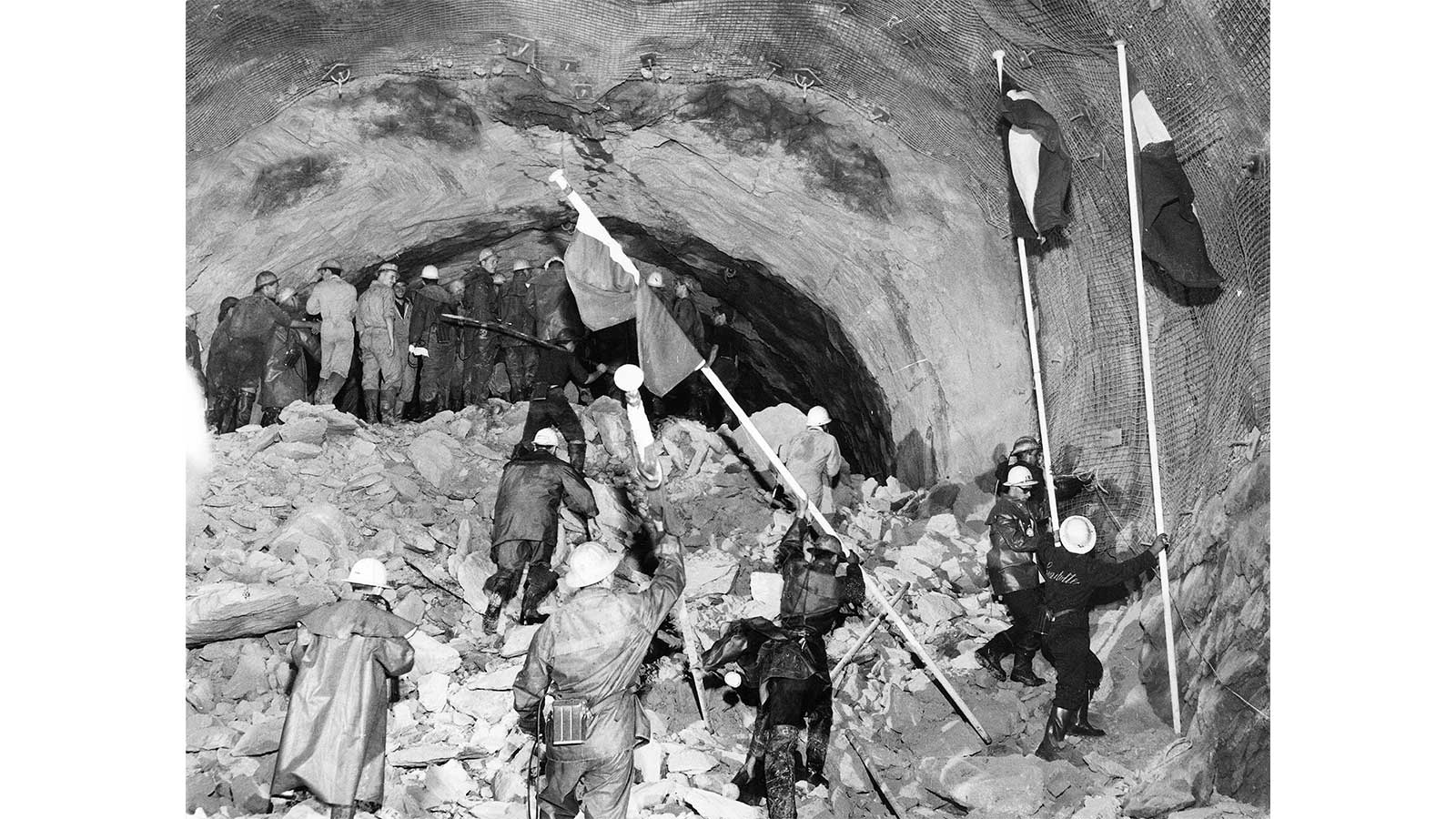
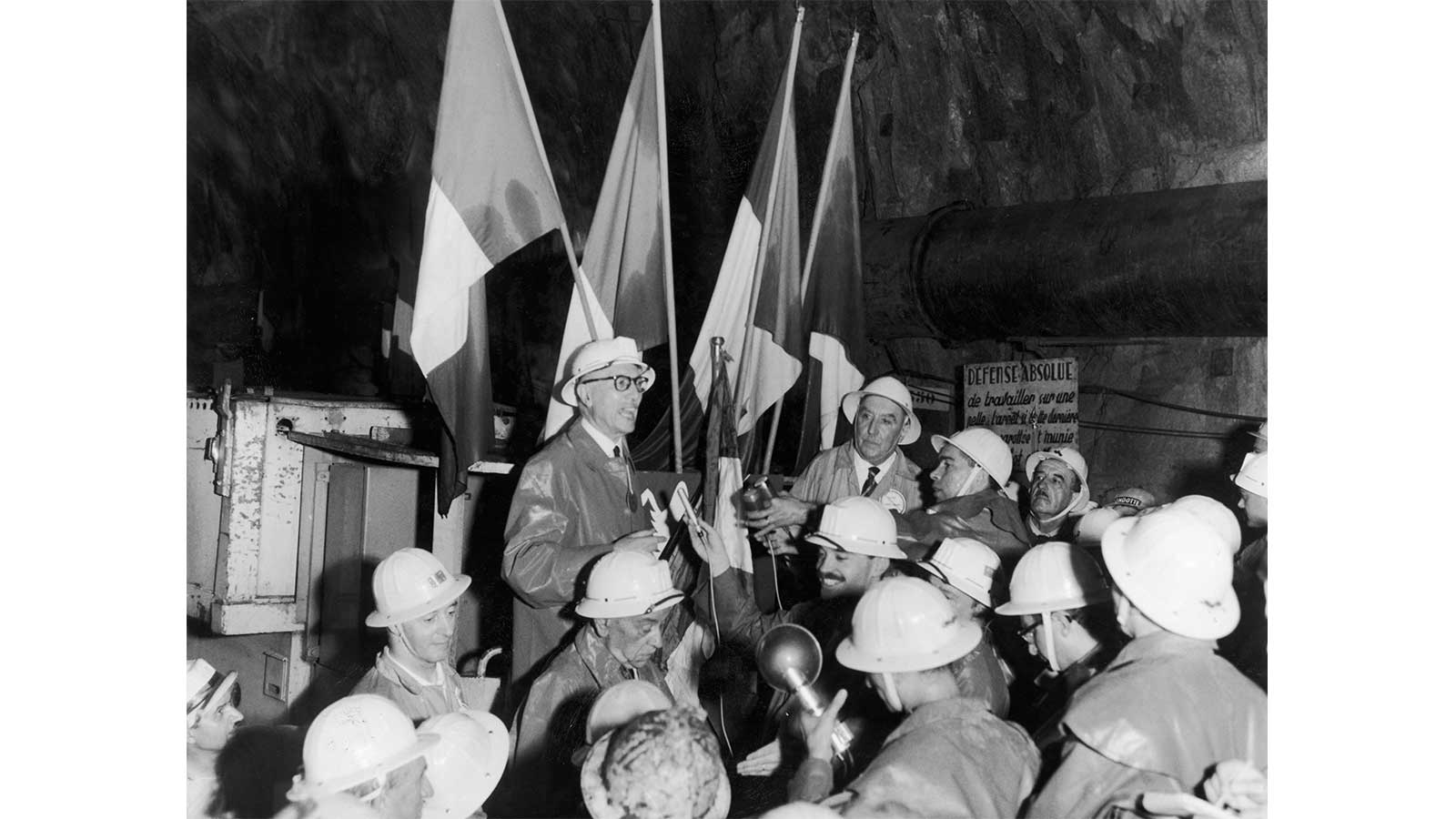
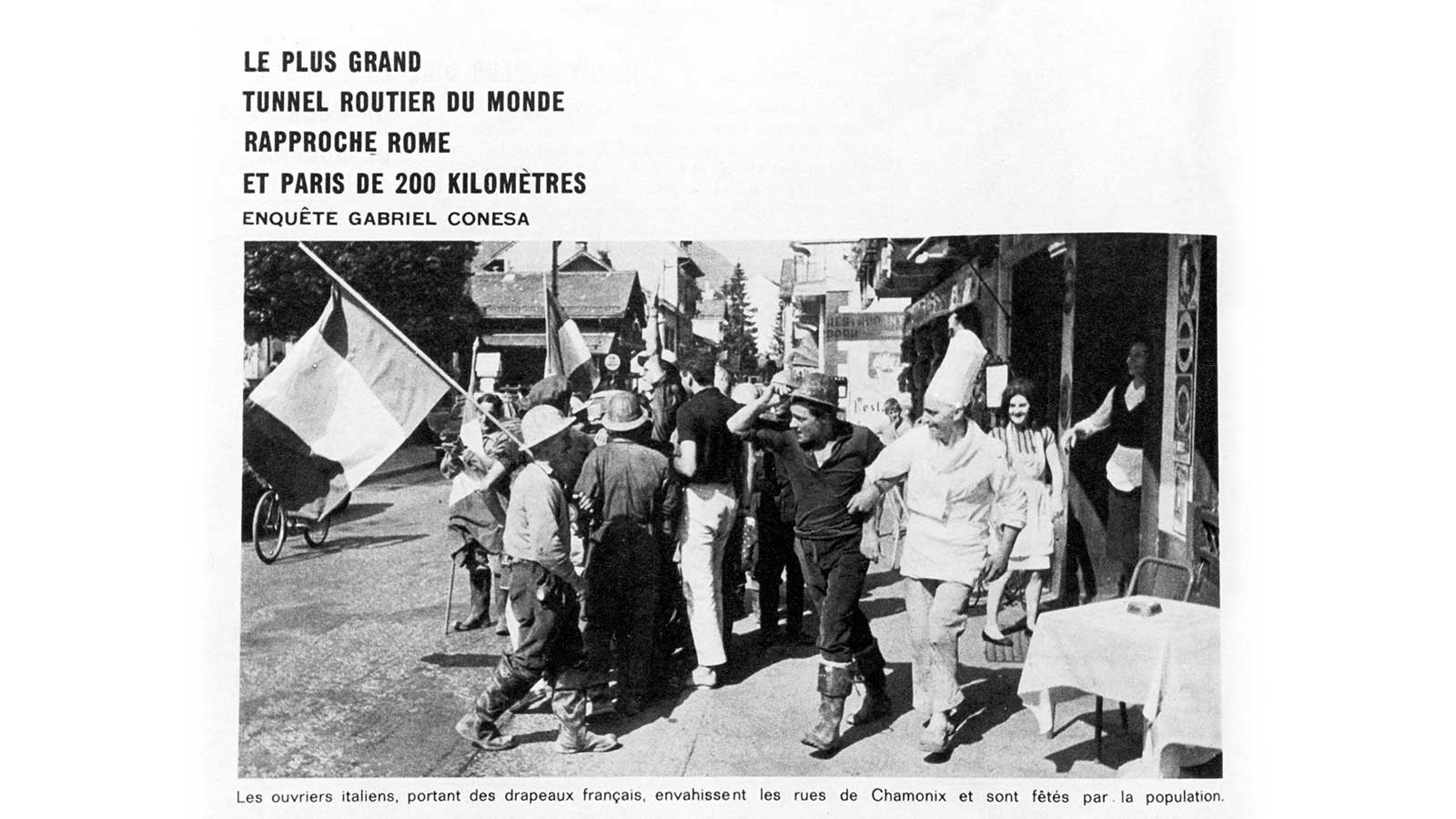
The end off the drilling of the Mont-Blanc Tunnel was officially celebrated on September 15th, 1962 by the heads of the French and Italian governments, Georges Pompidou and Amintore Fanfani. Beyond the technical and human exploit, the Mont-Blanc Tunnel rapidly emerged as a symbol of union between European countries: « A grandiose and symbolic tunnel, it is, for sure, a Franco-Italian enterprise, but tomorrow the Dutch, Belgians, British and others will use it, showing a desire to meet one another and to collaborate in a way which has never been so lively between the European peoples. … », declared Georges Pompidou, in his inaugural speech.
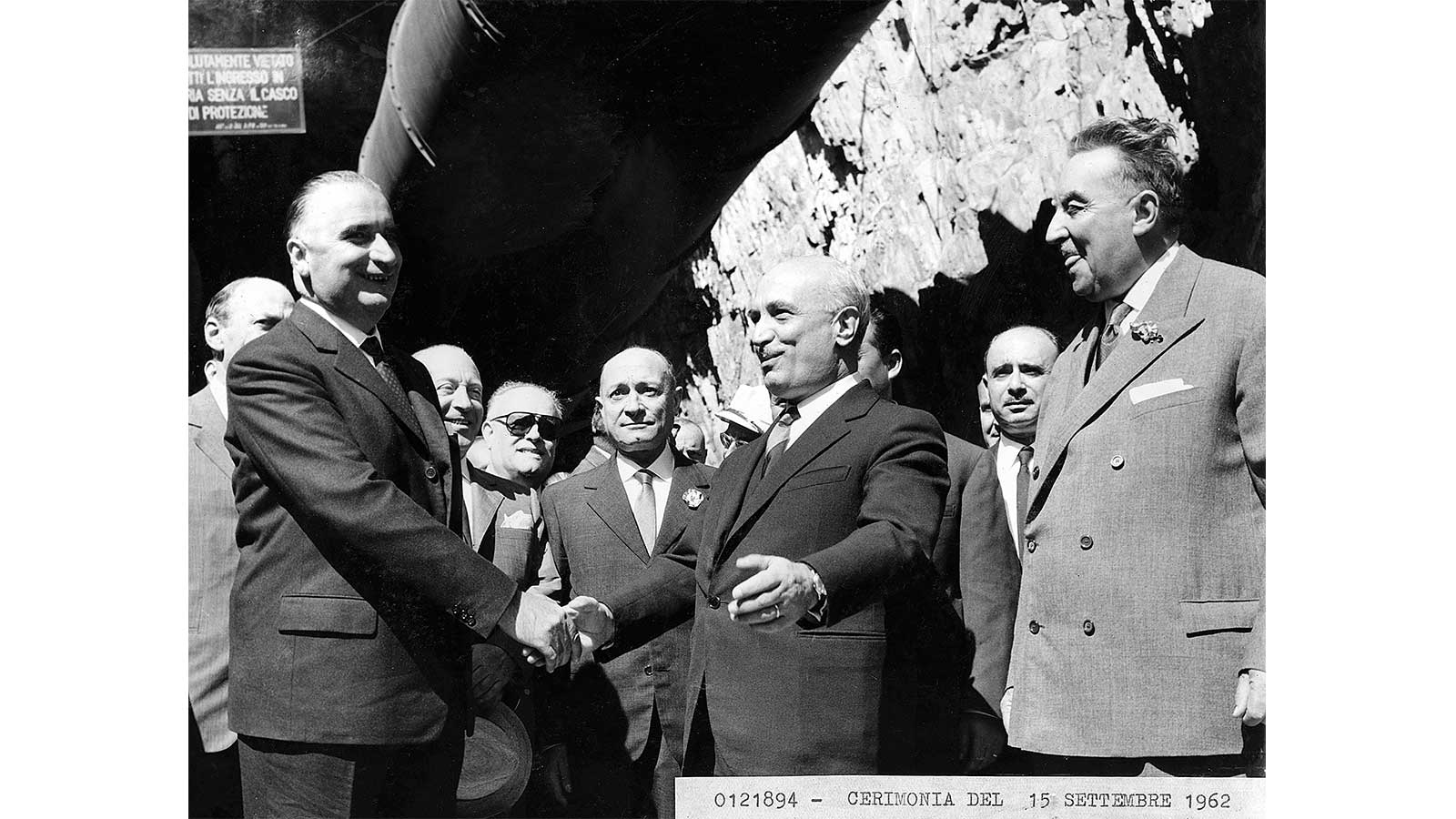
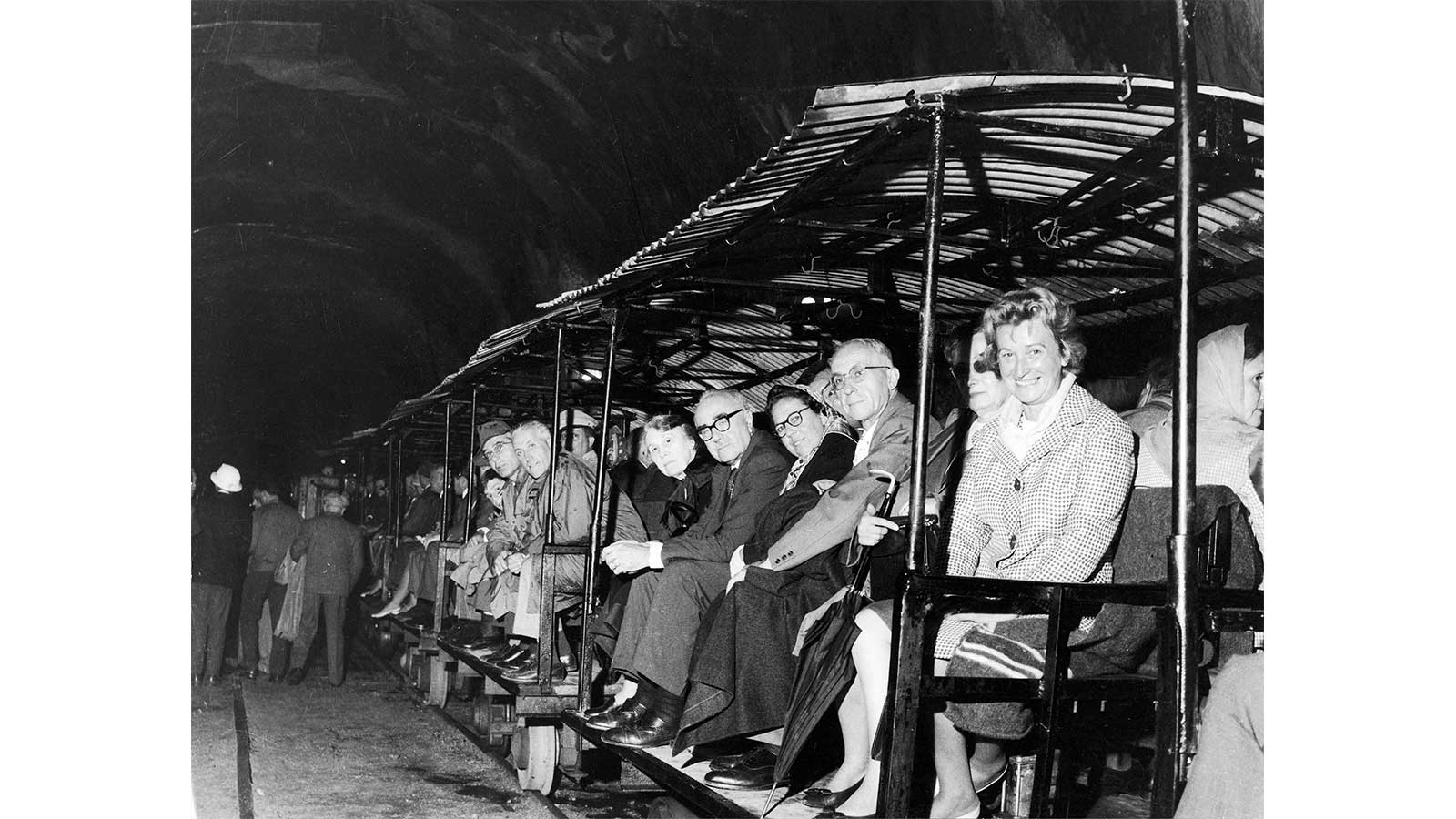
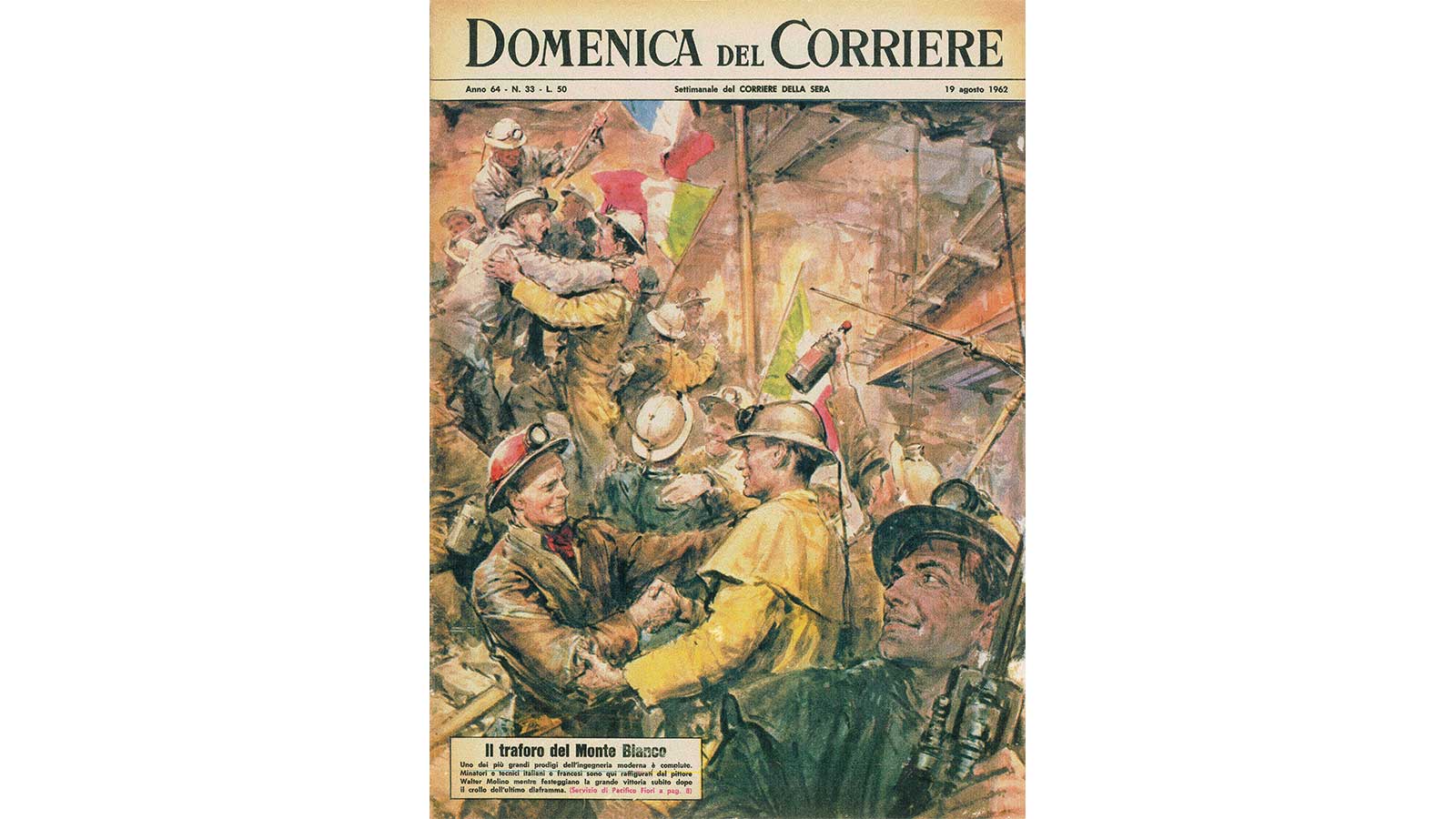
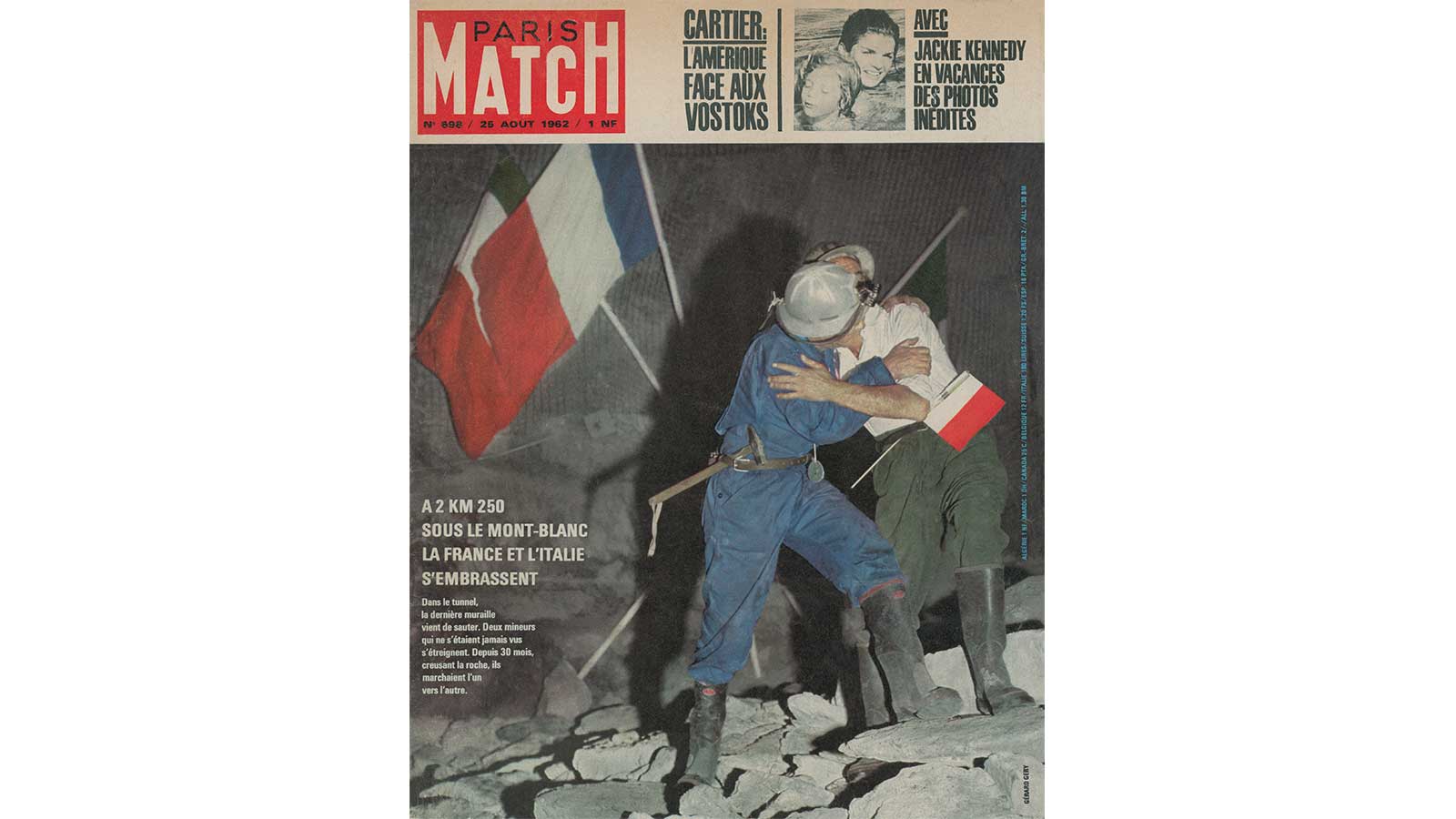
1965: the end of the work, a symbol of peace and a union at the heart of the «common market"
Three additional years passed finishing the internal work, laying the road, installing the technical equipment in the tunnel and equipping the two tunnel entrance aprons.
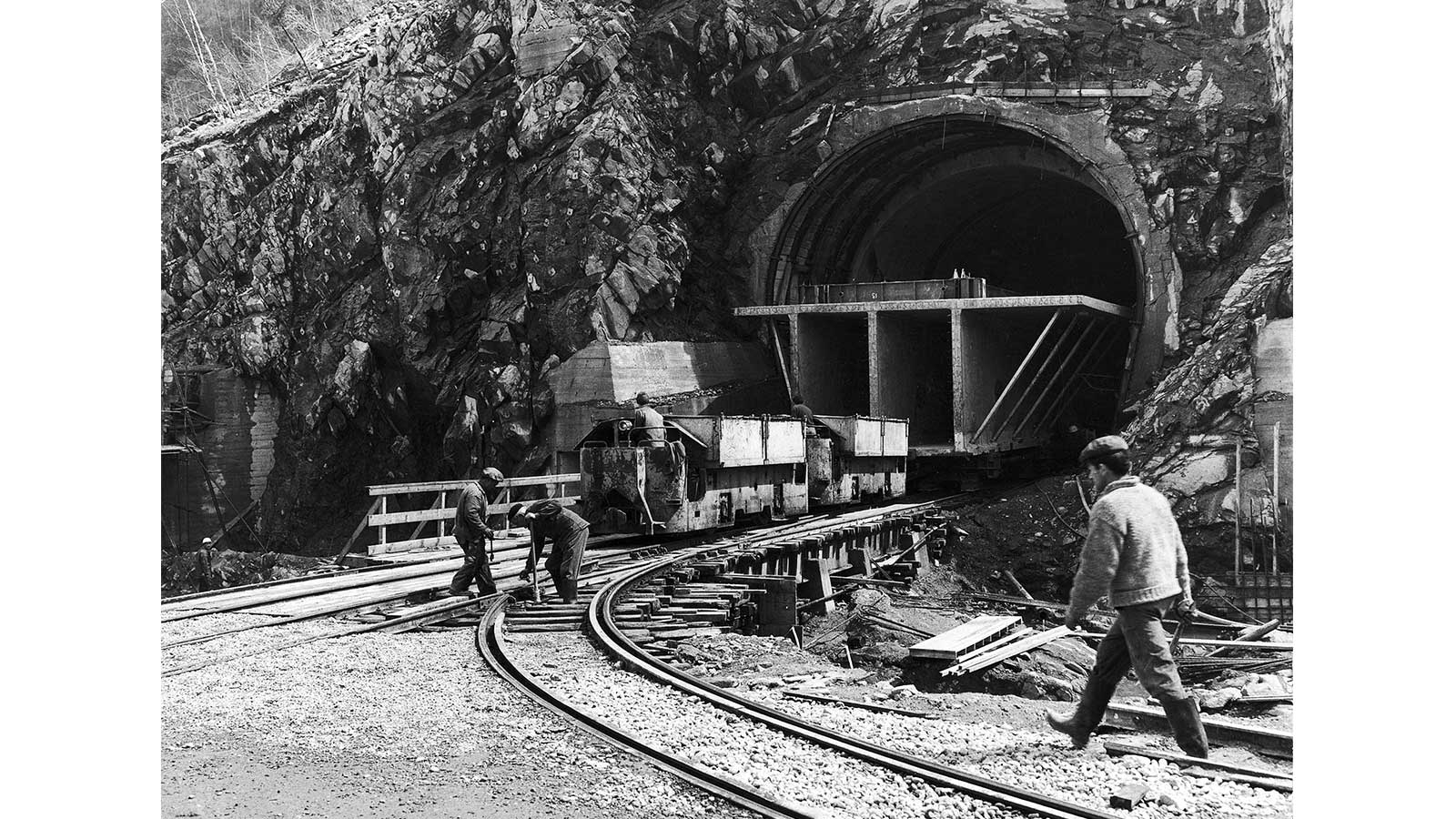
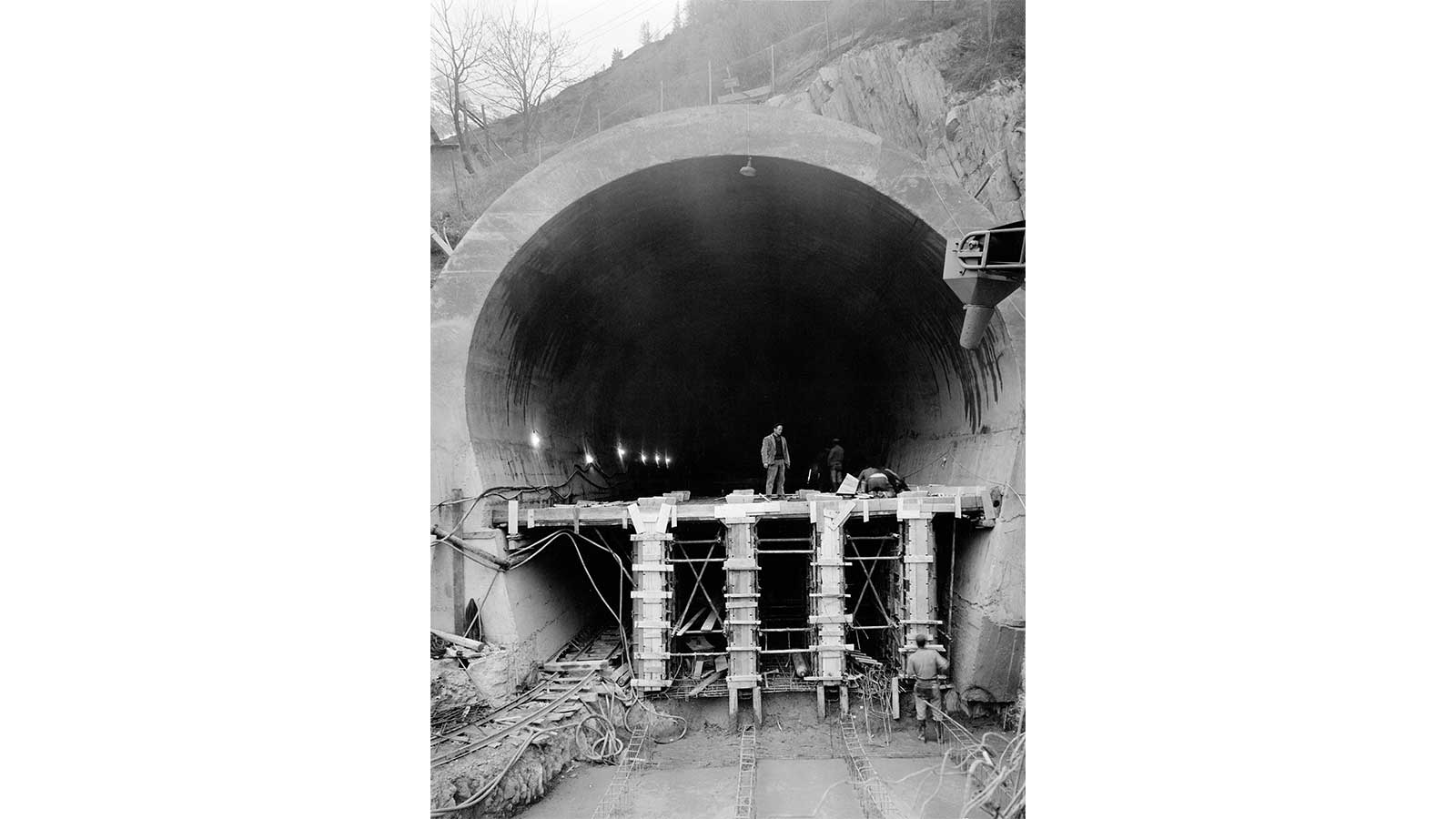
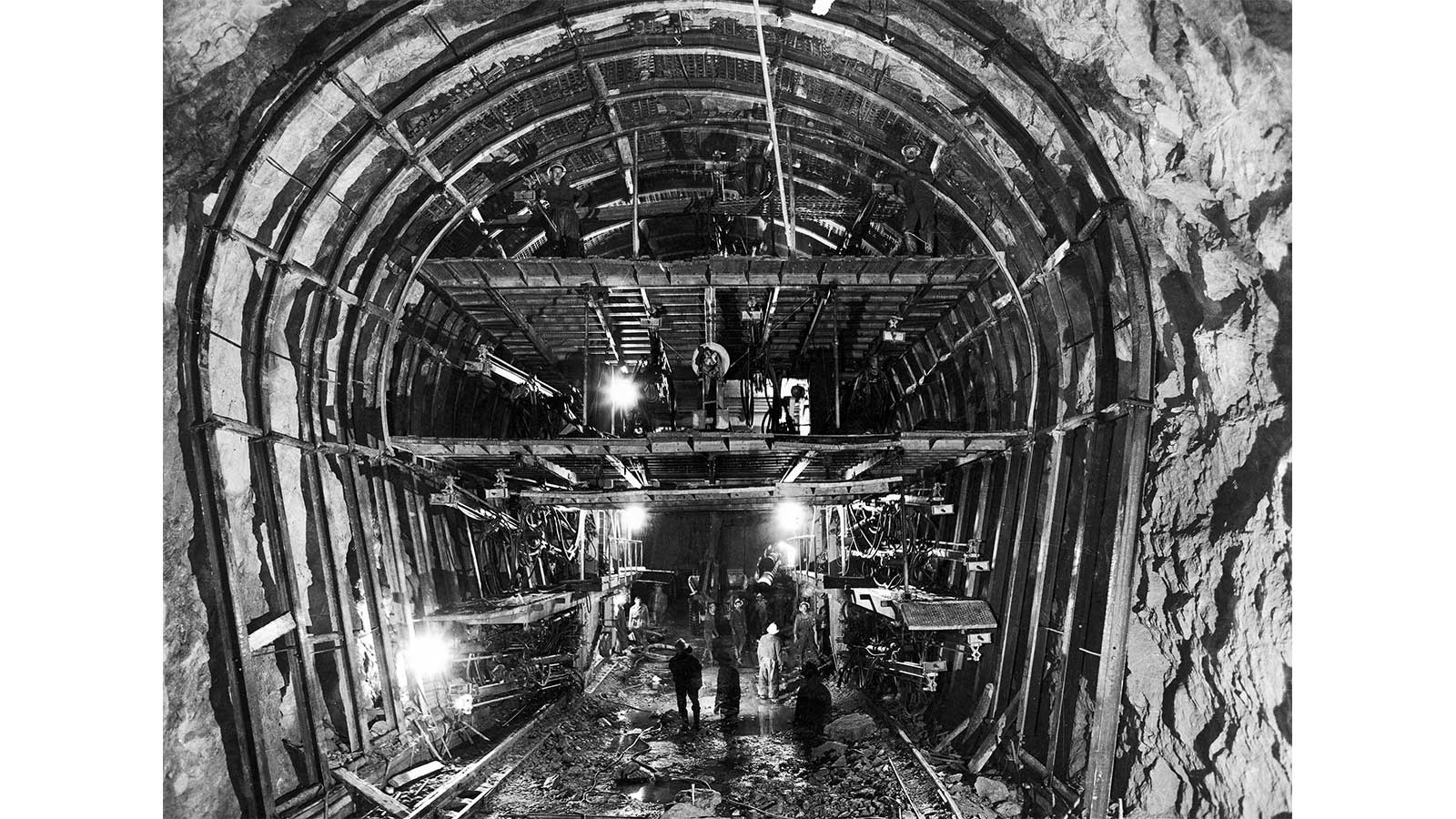
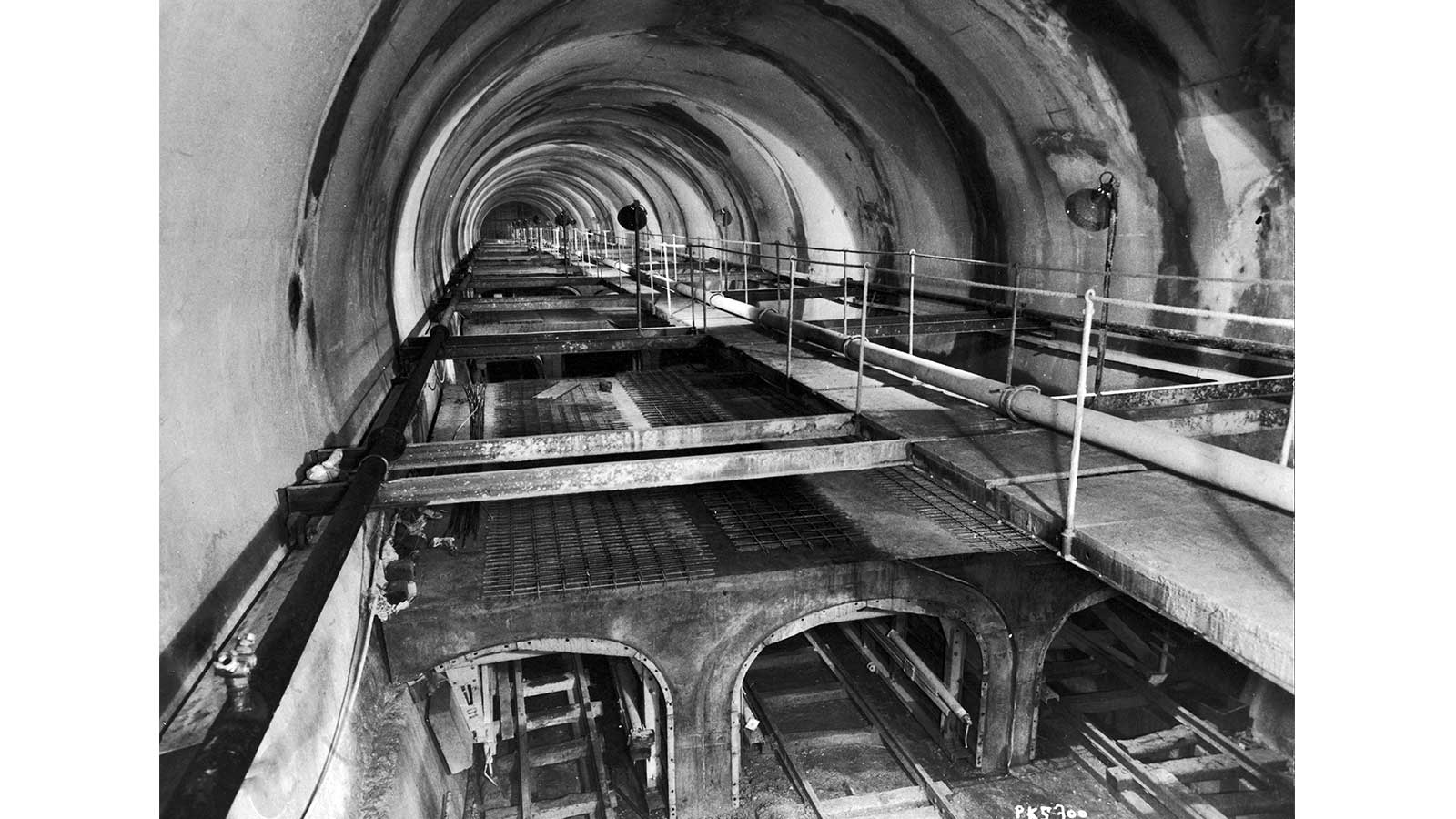
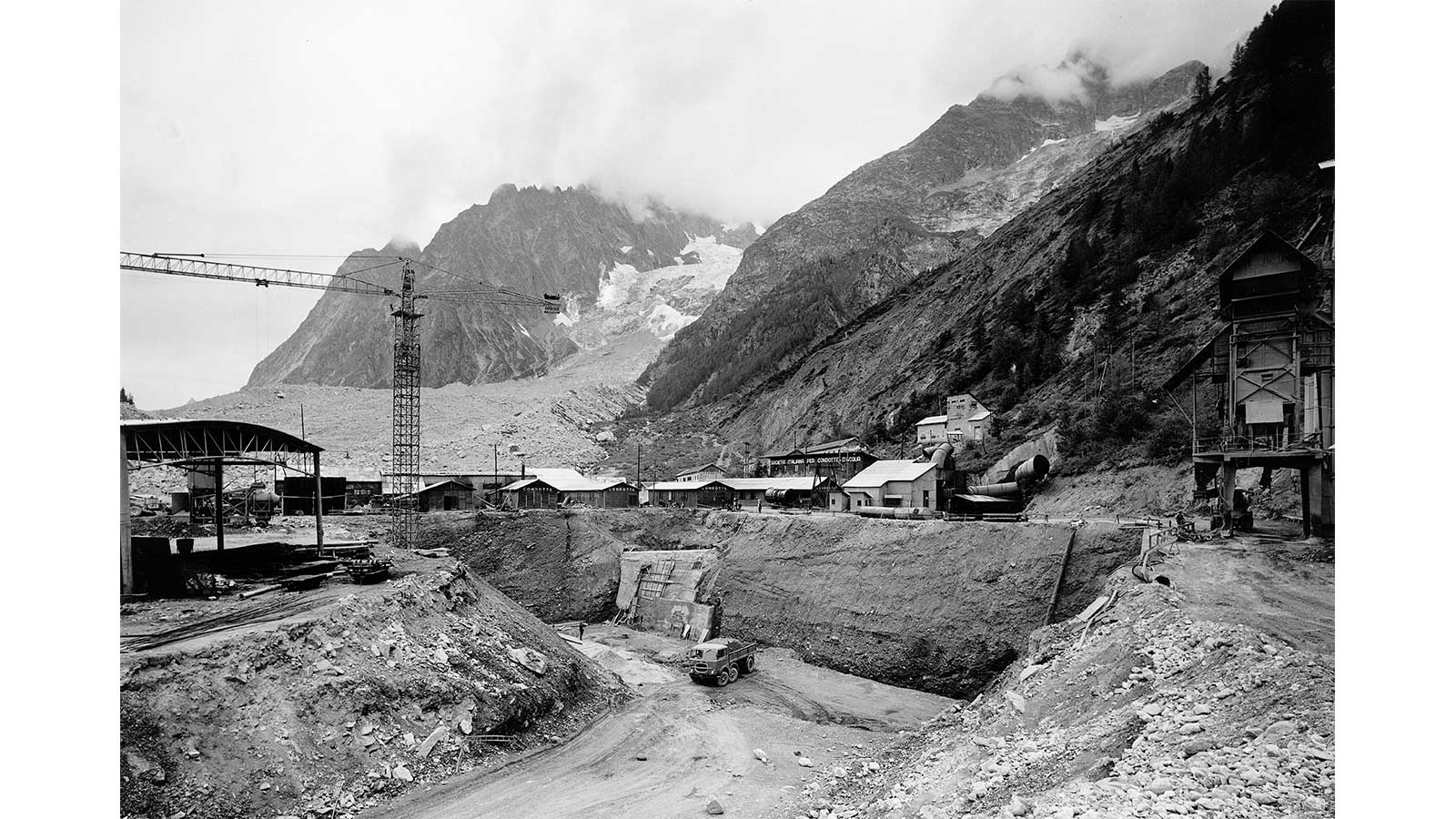
On July 16th, 1965, the Mont-Blanc Tunnel was inaugurated in the presence of the Italian President Giuseppe Saragat and the French President Charles de Gaulle. « …This work of peace which we are inaugurating today is for the world a symbol of willingness and trust in the virtue of the work of humans which builds day after day, the life of nations », declared Giuseppe Saragat.
Three days later, on July 19th at 6am, the Mont-Blanc Tunnel opened to traffic.
Dreamt of for centuries, imagined by visionaries, supported by audacious governments and created by brave men, the Mont-Blanc Tunnel establishes a fundamental axis for the fraternity found between the European peoples.
Three days later, on July 19th at 6am, the Mont-Blanc Tunnel opened to traffic.
Dreamt of for centuries, imagined by visionaries, supported by audacious governments and created by brave men, the Mont-Blanc Tunnel establishes a fundamental axis for the fraternity found between the European peoples.
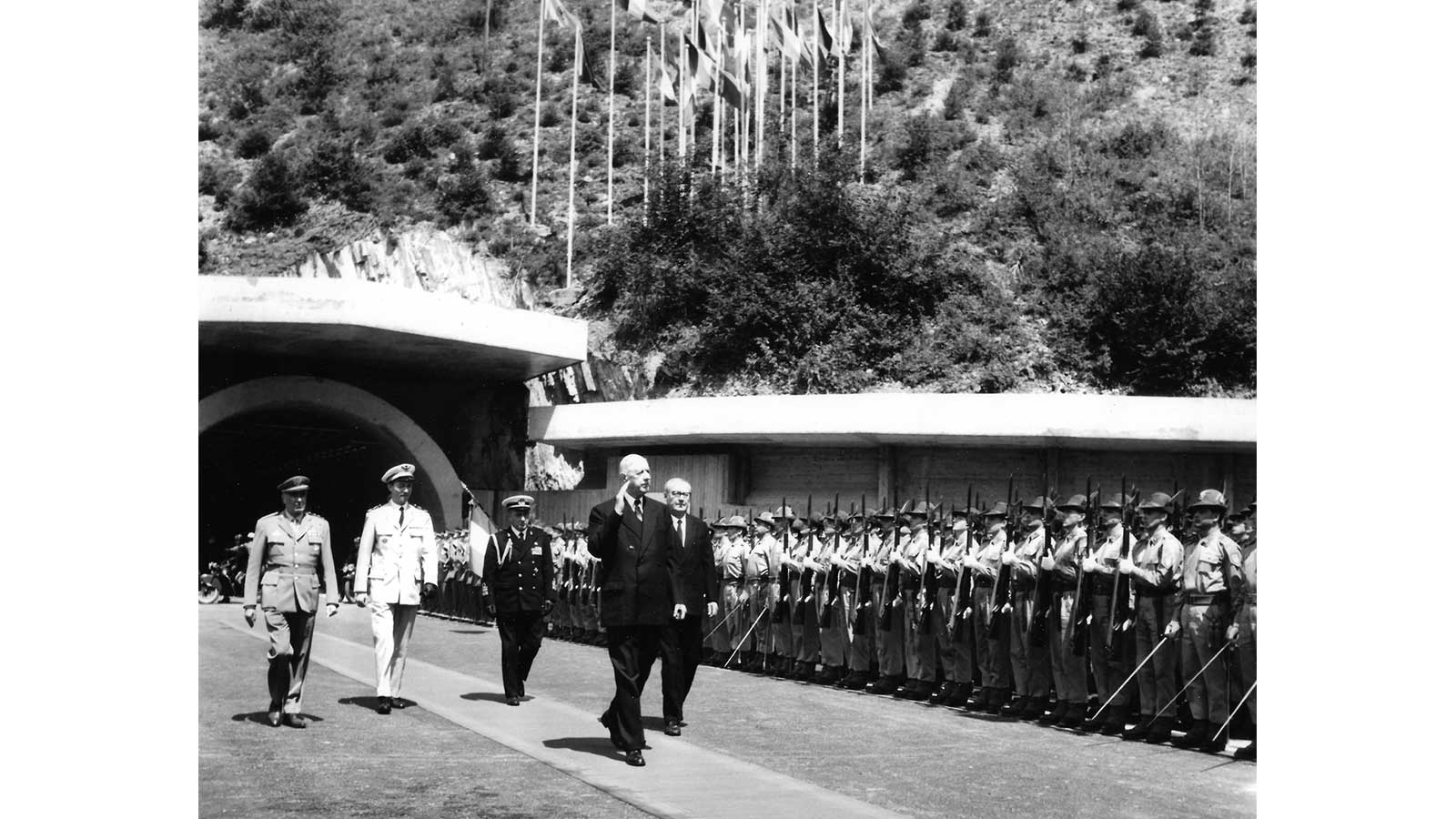
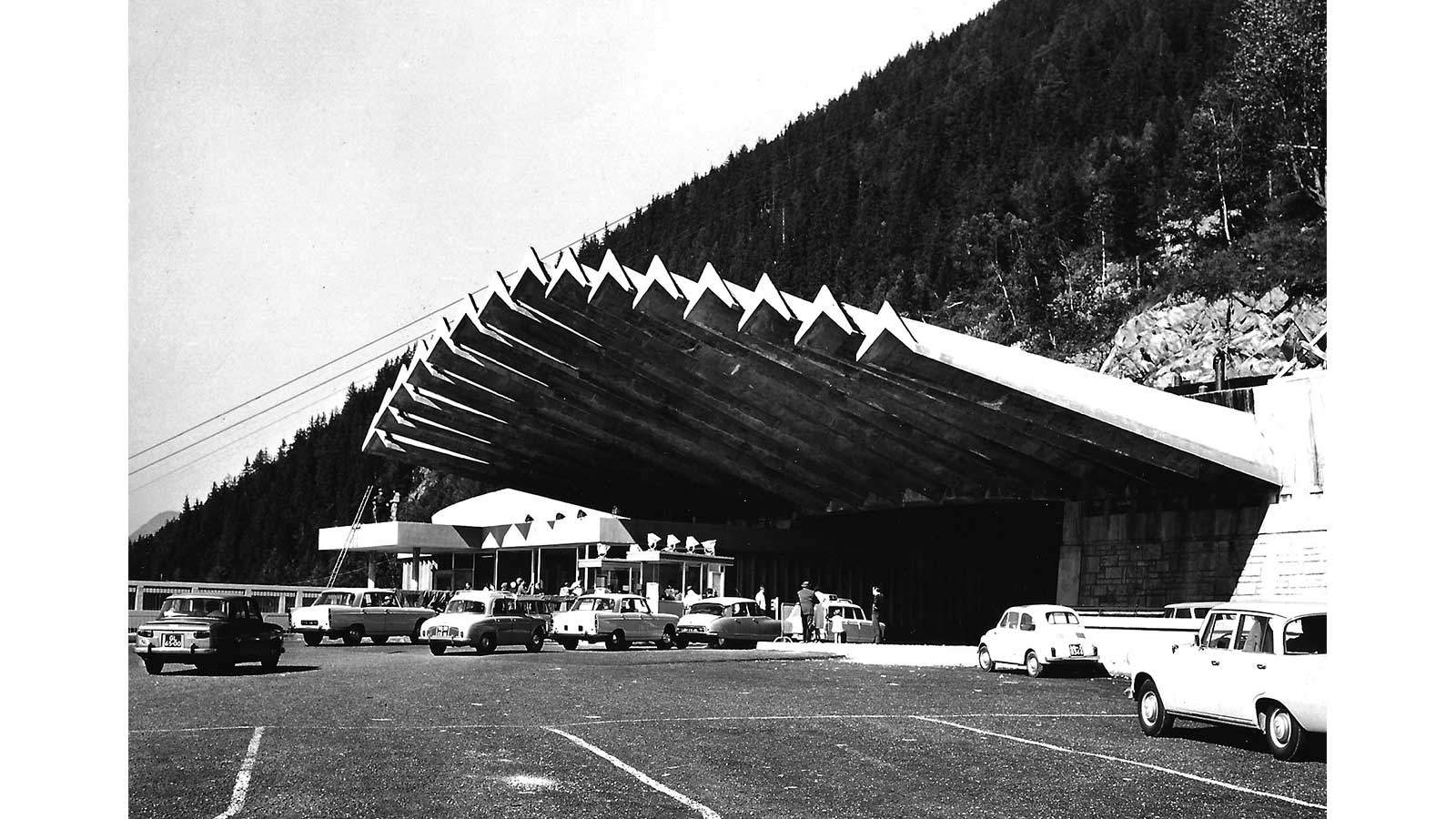
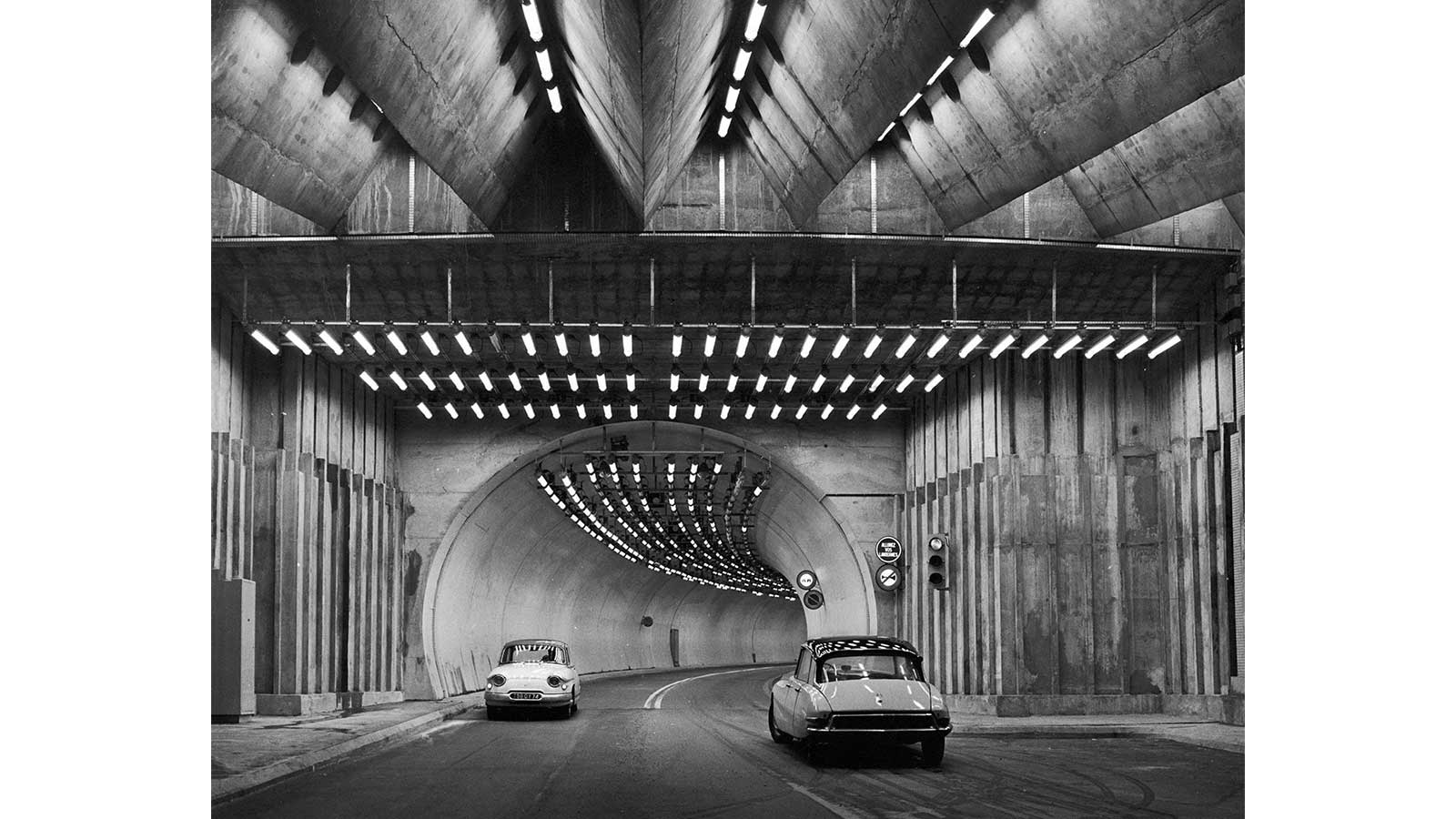
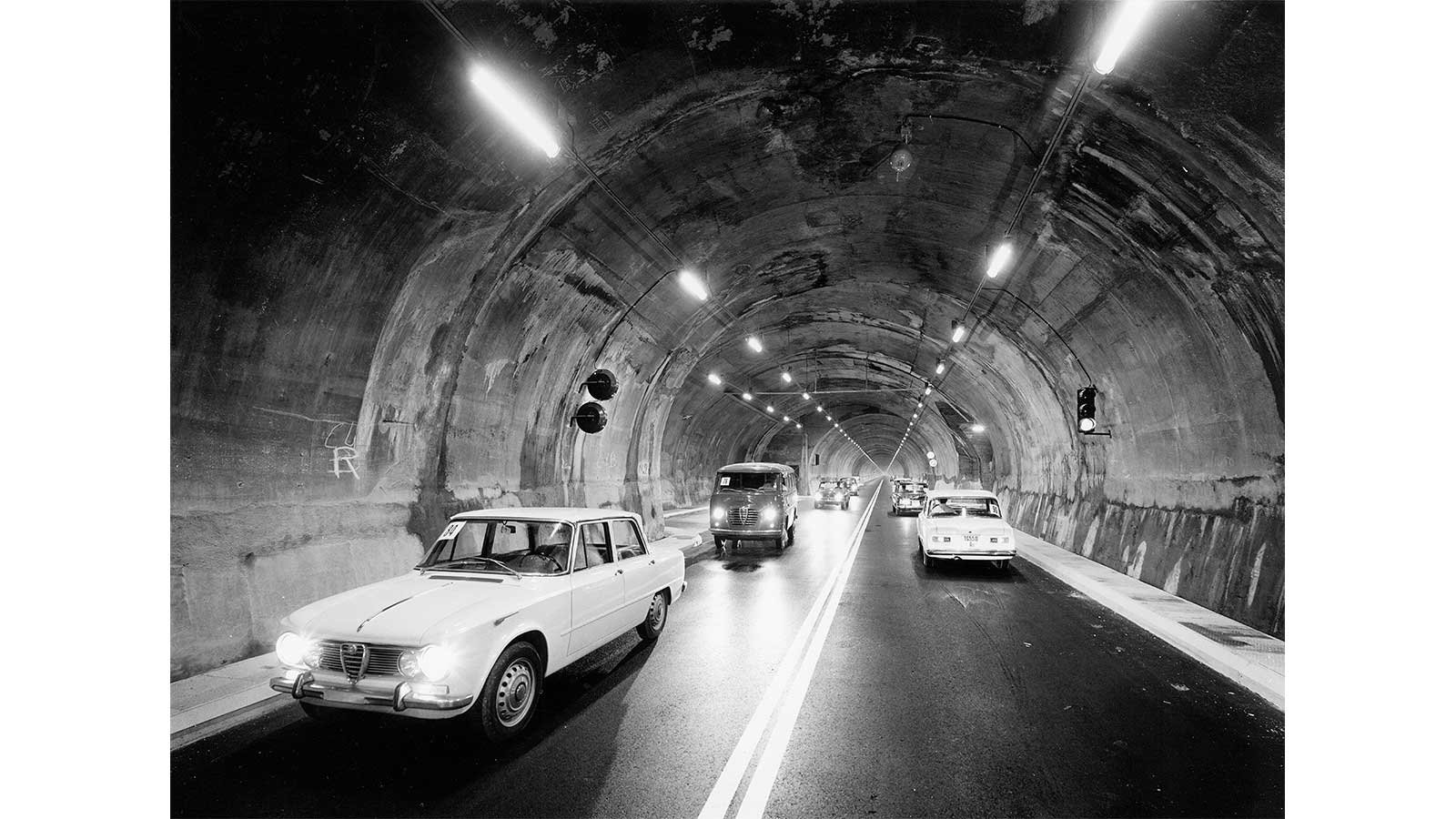
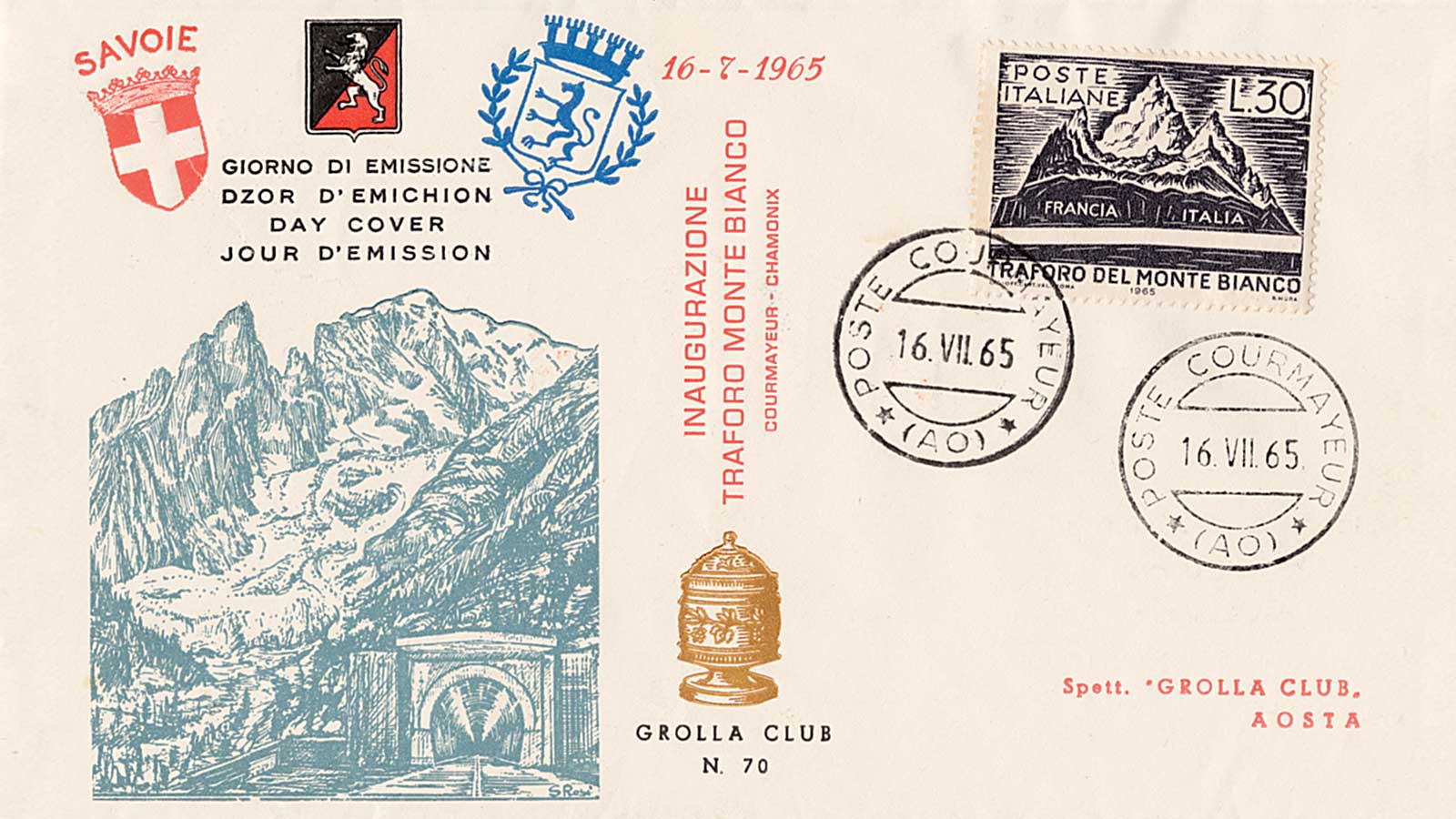
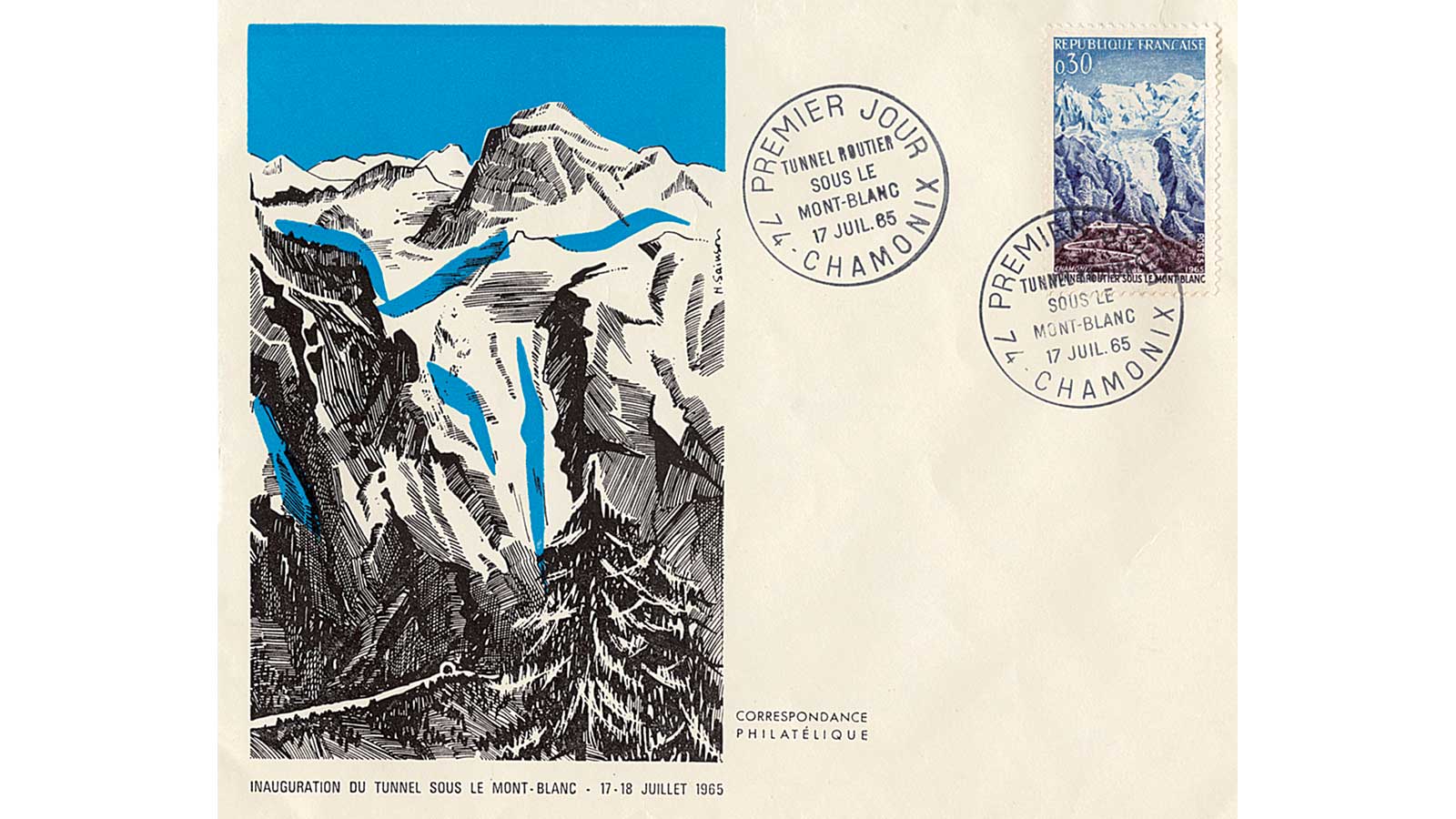
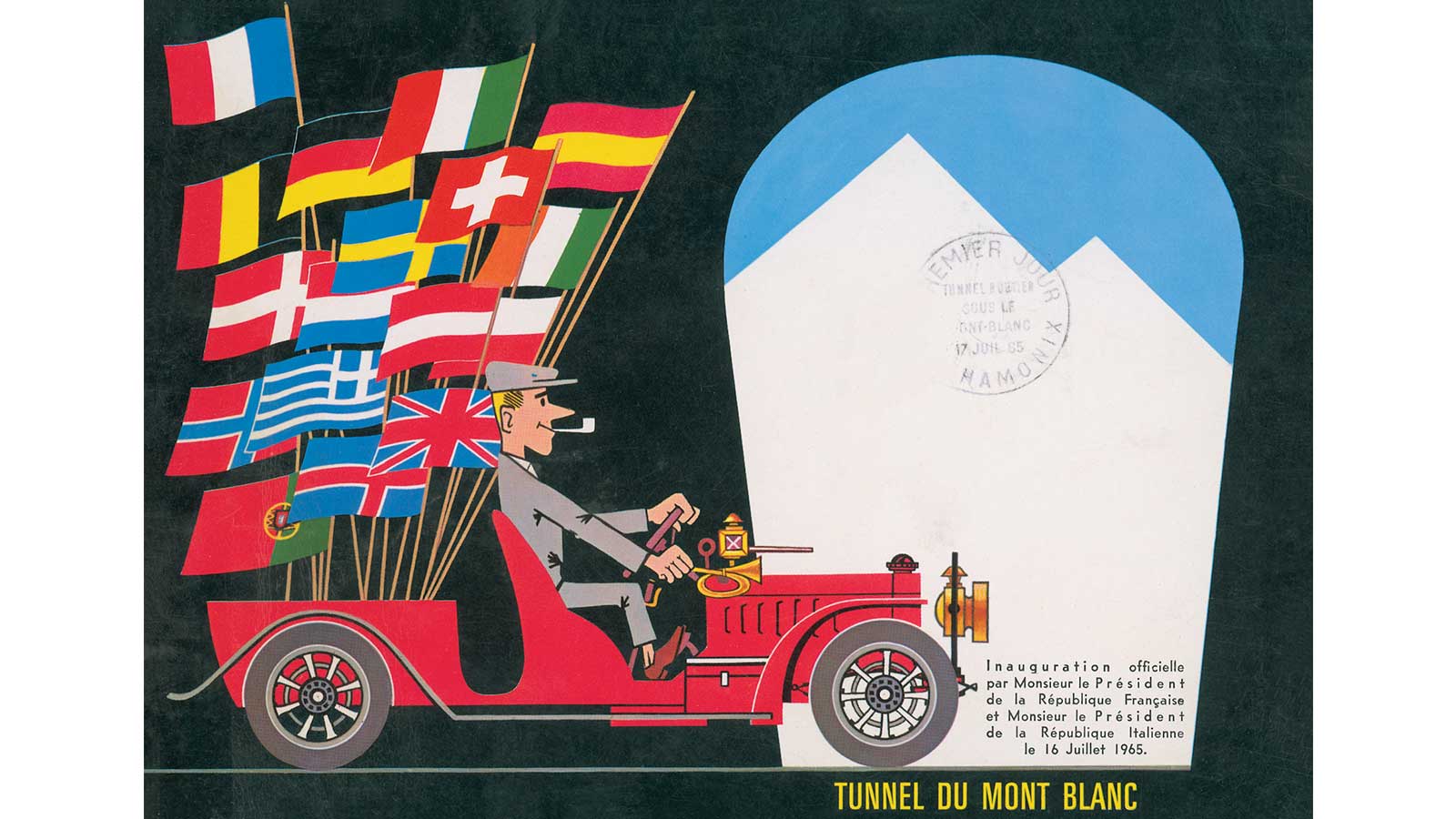
1999-2002: the modernisation of the Mont-Blanc Tunnel
In 1999, following the well-known accident of 24 March, the tunnel is closed to traffic. During the next three years, the concessionary companies are engaged in carrying out important restoration and modernisation works, adopting solutions that constitute a reference model on a world level and that are assimilated into the drawing up of the European directive on “minimum safety requirements for the tunnels of trans-European roads”, published in 2004. On March 9th, 2002, the tunnel is reopened to traffic.
The unitary management of the tunnel at the decision of the two Governments is entrusted to the GEIE-TMB, a legal entity set up under EU law and consisting equally of the two national concessionary companies of the tunnel, the French ATMB and the Italian SITMB.
The unitary management of the tunnel at the decision of the two Governments is entrusted to the GEIE-TMB, a legal entity set up under EU law and consisting equally of the two national concessionary companies of the tunnel, the French ATMB and the Italian SITMB.
2006: the convention of Lucca
In 2006, at the initiative of the Italian and French Governments, a new “Convention between the Government of the French Republic and the Government of the Italian Republic relating to the Mont Blanc Road Tunnel” is signed in Lucca, novating and replacing that of 1953; the expiry date of the concessions is set to 2050. On October 1st, 2008, after ratification by the Italian Parliament with Law 166 of 27 September 2007 and by the French Parliament with Law 2008-575 of June 19th, 2008, the new international Convention between Italy and France comes fully into effect.
We only use those technical cookies which are strictly necessary to ensure you get the best possible experience on our website, as indicated in our cookie policy.